Management Accounting Solutions for Bizdaq
VerifiedAdded on 2020/06/06
|21
|5528
|197
AI Summary
This assignment explores the financial difficulties encountered by a company named Bizdaq, which include excessive debt, poor purchasing decisions, and ineffective investment choices. The focus is on how management accounting tools can help Bizdaq improve sales revenue, return on capital invested, and overall financial performance. The solution proposes using Key Performance Indicators (KPIs), benchmarking against competitors, and implementing robust budgetary control measures to address these issues.
Contribute Materials
Your contribution can guide someone’s learning journey. Share your
documents today.
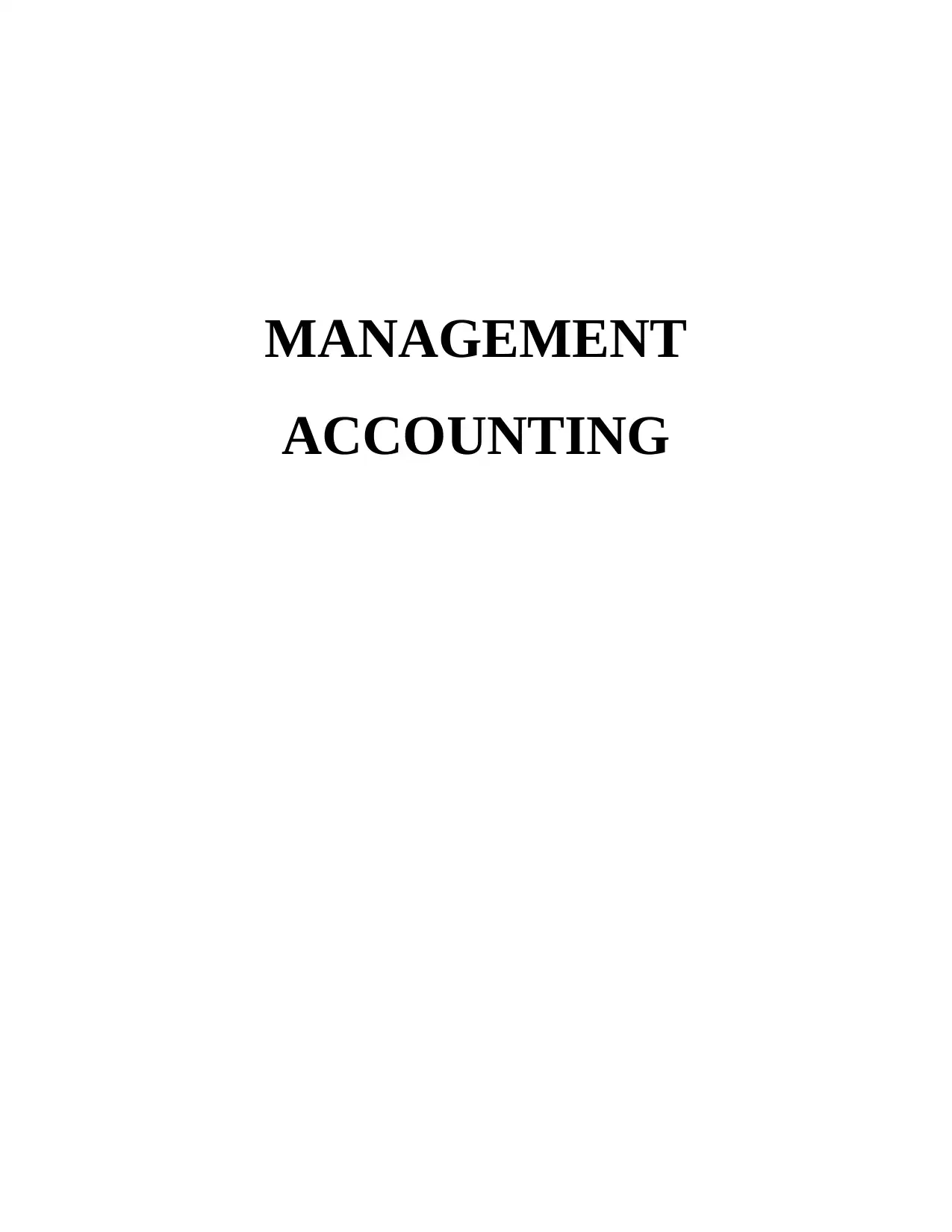
MANAGEMENT
ACCOUNTING
ACCOUNTING
Secure Best Marks with AI Grader
Need help grading? Try our AI Grader for instant feedback on your assignments.
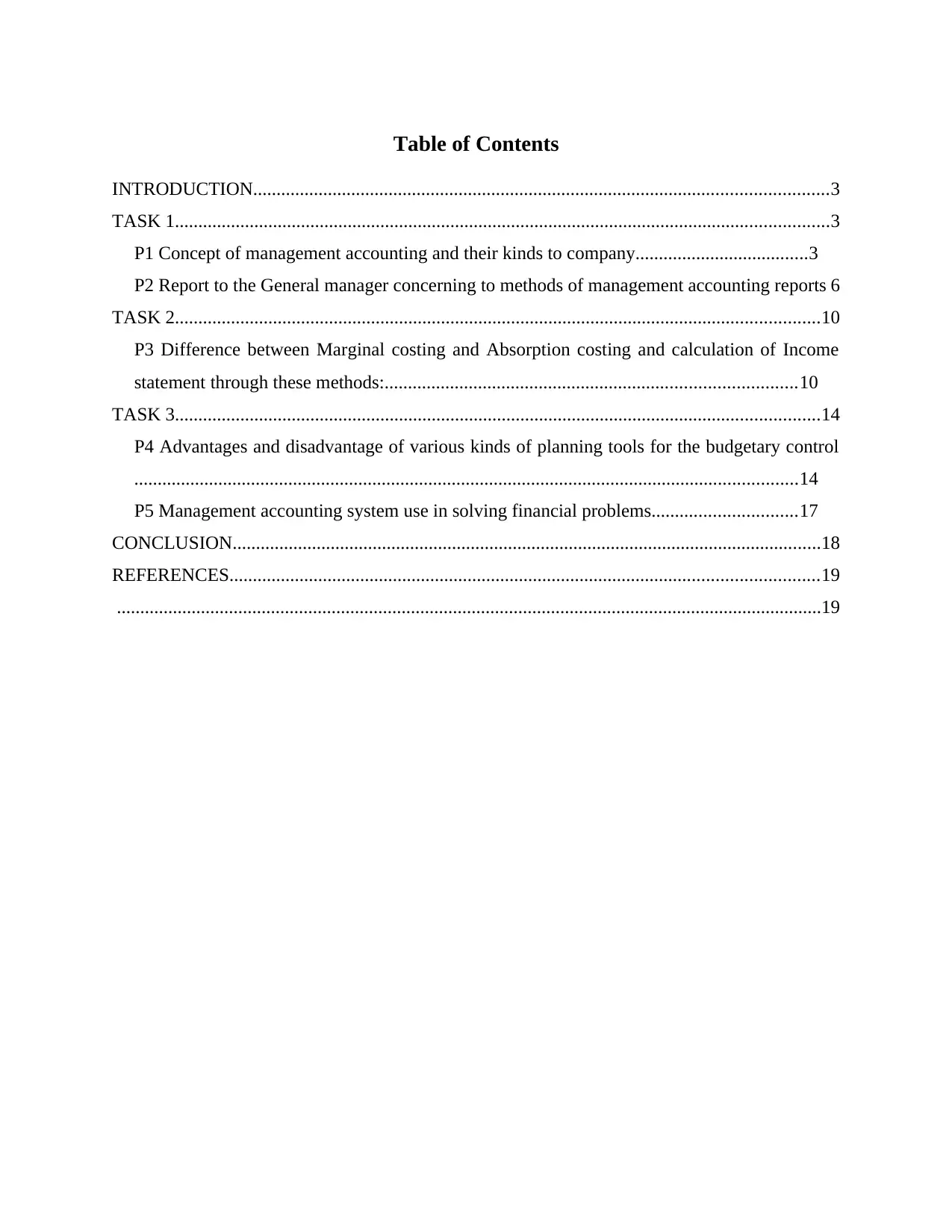
Table of Contents
INTRODUCTION...........................................................................................................................3
TASK 1............................................................................................................................................3
P1 Concept of management accounting and their kinds to company.....................................3
P2 Report to the General manager concerning to methods of management accounting reports 6
TASK 2..........................................................................................................................................10
P3 Difference between Marginal costing and Absorption costing and calculation of Income
statement through these methods:........................................................................................10
TASK 3..........................................................................................................................................14
P4 Advantages and disadvantage of various kinds of planning tools for the budgetary control
..............................................................................................................................................14
P5 Management accounting system use in solving financial problems...............................17
CONCLUSION..............................................................................................................................18
REFERENCES..............................................................................................................................19
.......................................................................................................................................................19
INTRODUCTION...........................................................................................................................3
TASK 1............................................................................................................................................3
P1 Concept of management accounting and their kinds to company.....................................3
P2 Report to the General manager concerning to methods of management accounting reports 6
TASK 2..........................................................................................................................................10
P3 Difference between Marginal costing and Absorption costing and calculation of Income
statement through these methods:........................................................................................10
TASK 3..........................................................................................................................................14
P4 Advantages and disadvantage of various kinds of planning tools for the budgetary control
..............................................................................................................................................14
P5 Management accounting system use in solving financial problems...............................17
CONCLUSION..............................................................................................................................18
REFERENCES..............................................................................................................................19
.......................................................................................................................................................19
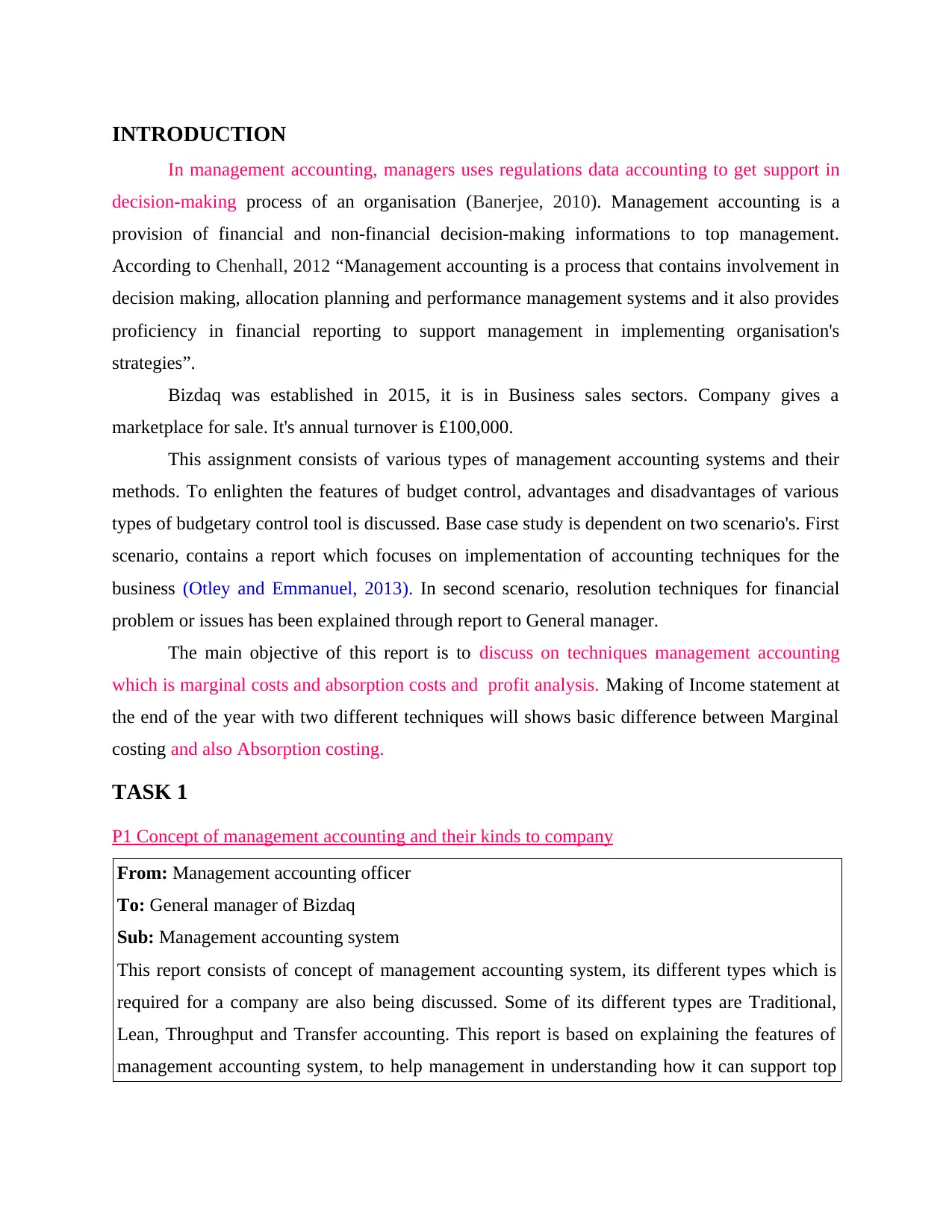
INTRODUCTION
In management accounting, managers uses regulations data accounting to get support in
decision-making process of an organisation (Banerjee, 2010). Management accounting is a
provision of financial and non-financial decision-making informations to top management.
According to Chenhall, 2012 “Management accounting is a process that contains involvement in
decision making, allocation planning and performance management systems and it also provides
proficiency in financial reporting to support management in implementing organisation's
strategies”.
Bizdaq was established in 2015, it is in Business sales sectors. Company gives a
marketplace for sale. It's annual turnover is £100,000.
This assignment consists of various types of management accounting systems and their
methods. To enlighten the features of budget control, advantages and disadvantages of various
types of budgetary control tool is discussed. Base case study is dependent on two scenario's. First
scenario, contains a report which focuses on implementation of accounting techniques for the
business (Otley and Emmanuel, 2013). In second scenario, resolution techniques for financial
problem or issues has been explained through report to General manager.
The main objective of this report is to discuss on techniques management accounting
which is marginal costs and absorption costs and profit analysis. Making of Income statement at
the end of the year with two different techniques will shows basic difference between Marginal
costing and also Absorption costing.
TASK 1
P1 Concept of management accounting and their kinds to company
From: Management accounting officer
To: General manager of Bizdaq
Sub: Management accounting system
This report consists of concept of management accounting system, its different types which is
required for a company are also being discussed. Some of its different types are Traditional,
Lean, Throughput and Transfer accounting. This report is based on explaining the features of
management accounting system, to help management in understanding how it can support top
In management accounting, managers uses regulations data accounting to get support in
decision-making process of an organisation (Banerjee, 2010). Management accounting is a
provision of financial and non-financial decision-making informations to top management.
According to Chenhall, 2012 “Management accounting is a process that contains involvement in
decision making, allocation planning and performance management systems and it also provides
proficiency in financial reporting to support management in implementing organisation's
strategies”.
Bizdaq was established in 2015, it is in Business sales sectors. Company gives a
marketplace for sale. It's annual turnover is £100,000.
This assignment consists of various types of management accounting systems and their
methods. To enlighten the features of budget control, advantages and disadvantages of various
types of budgetary control tool is discussed. Base case study is dependent on two scenario's. First
scenario, contains a report which focuses on implementation of accounting techniques for the
business (Otley and Emmanuel, 2013). In second scenario, resolution techniques for financial
problem or issues has been explained through report to General manager.
The main objective of this report is to discuss on techniques management accounting
which is marginal costs and absorption costs and profit analysis. Making of Income statement at
the end of the year with two different techniques will shows basic difference between Marginal
costing and also Absorption costing.
TASK 1
P1 Concept of management accounting and their kinds to company
From: Management accounting officer
To: General manager of Bizdaq
Sub: Management accounting system
This report consists of concept of management accounting system, its different types which is
required for a company are also being discussed. Some of its different types are Traditional,
Lean, Throughput and Transfer accounting. This report is based on explaining the features of
management accounting system, to help management in understanding how it can support top
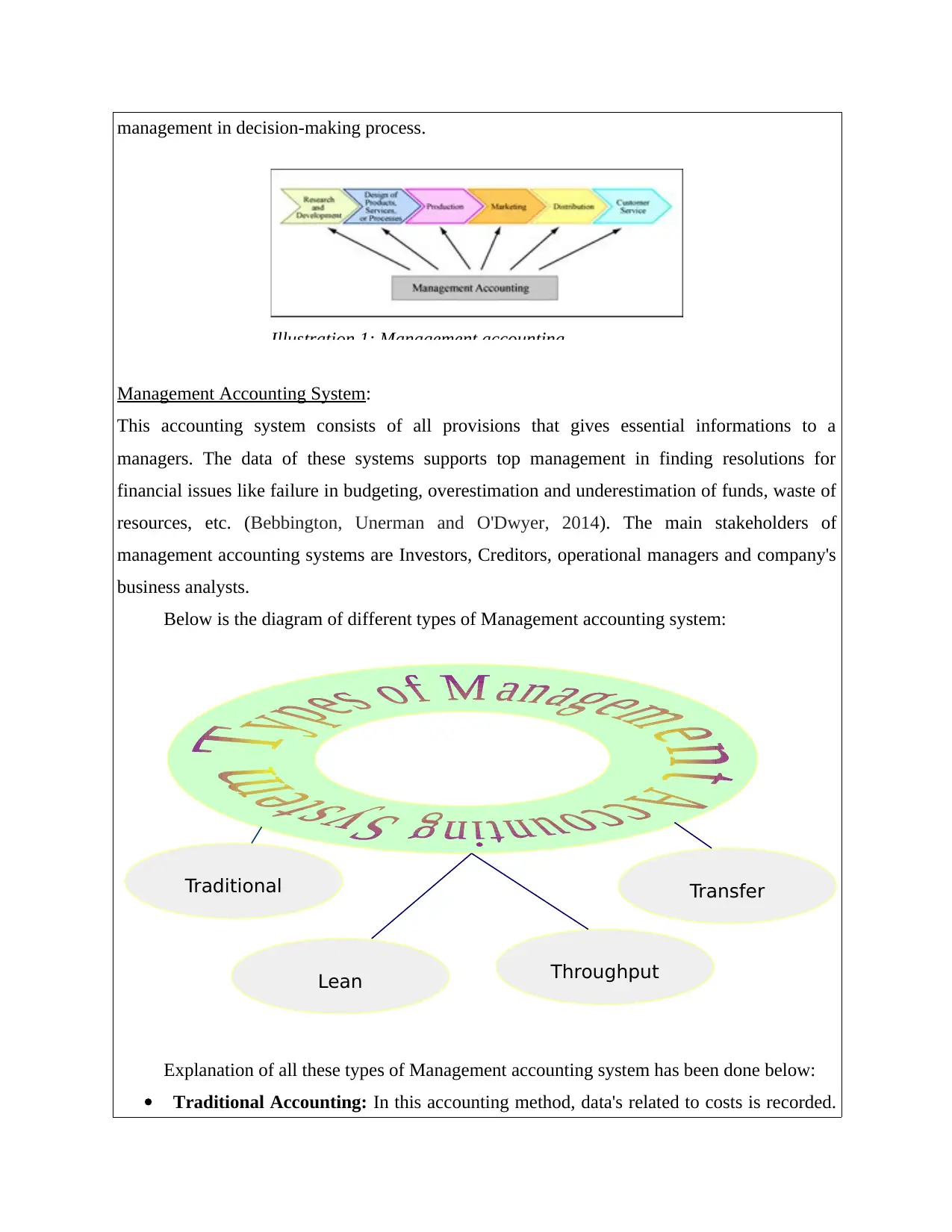
management in decision-making process.
Management Accounting System:
This accounting system consists of all provisions that gives essential informations to a
managers. The data of these systems supports top management in finding resolutions for
financial issues like failure in budgeting, overestimation and underestimation of funds, waste of
resources, etc. (Bebbington, Unerman and O'Dwyer, 2014). The main stakeholders of
management accounting systems are Investors, Creditors, operational managers and company's
business analysts.
Below is the diagram of different types of Management accounting system:
Explanation of all these types of Management accounting system has been done below:
Traditional Accounting: In this accounting method, data's related to costs is recorded.
Traditional Transfer
ThroughputLean
Illustration 1: Management accounting
Management Accounting System:
This accounting system consists of all provisions that gives essential informations to a
managers. The data of these systems supports top management in finding resolutions for
financial issues like failure in budgeting, overestimation and underestimation of funds, waste of
resources, etc. (Bebbington, Unerman and O'Dwyer, 2014). The main stakeholders of
management accounting systems are Investors, Creditors, operational managers and company's
business analysts.
Below is the diagram of different types of Management accounting system:
Explanation of all these types of Management accounting system has been done below:
Traditional Accounting: In this accounting method, data's related to costs is recorded.
Traditional Transfer
ThroughputLean
Illustration 1: Management accounting
Secure Best Marks with AI Grader
Need help grading? Try our AI Grader for instant feedback on your assignments.
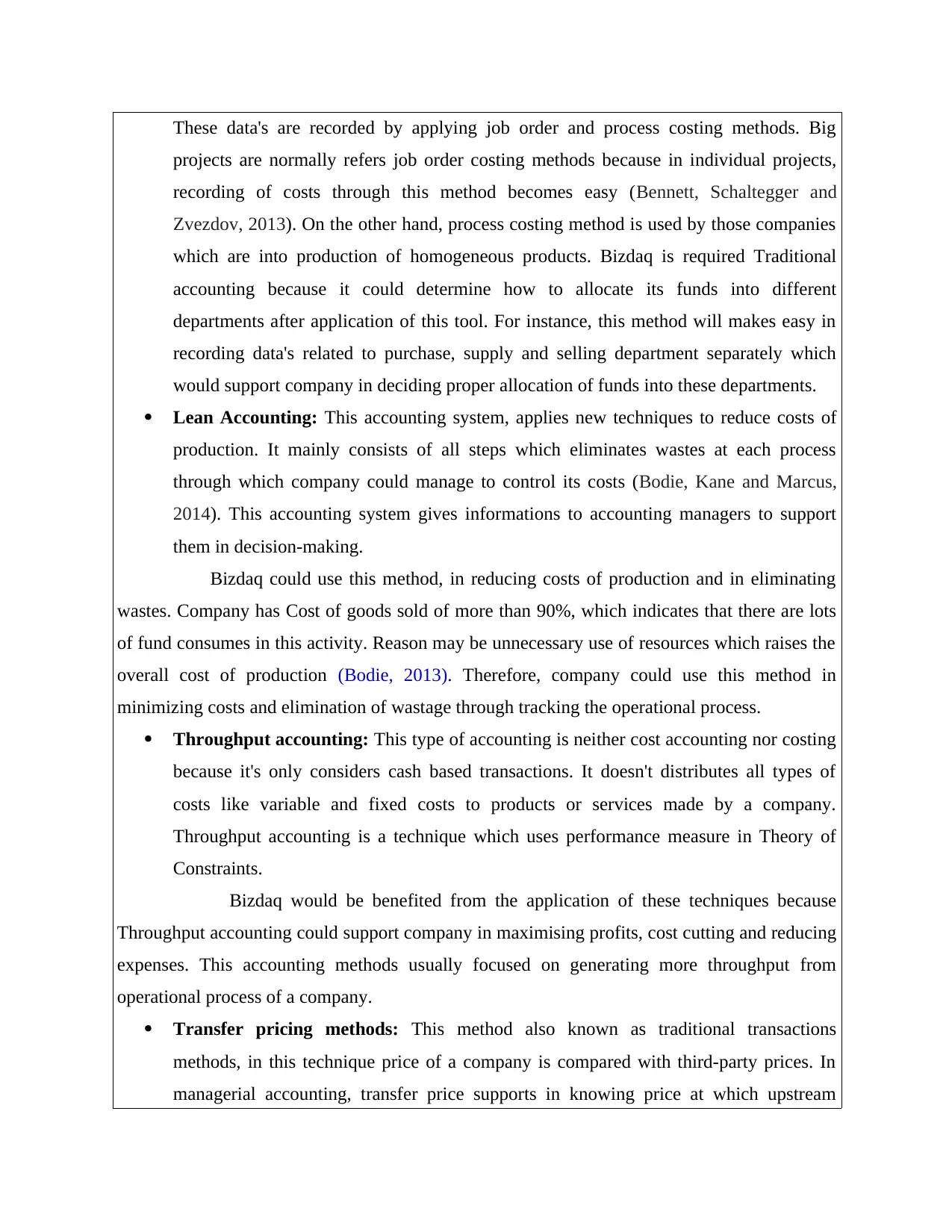
These data's are recorded by applying job order and process costing methods. Big
projects are normally refers job order costing methods because in individual projects,
recording of costs through this method becomes easy (Bennett, Schaltegger and
Zvezdov, 2013). On the other hand, process costing method is used by those companies
which are into production of homogeneous products. Bizdaq is required Traditional
accounting because it could determine how to allocate its funds into different
departments after application of this tool. For instance, this method will makes easy in
recording data's related to purchase, supply and selling department separately which
would support company in deciding proper allocation of funds into these departments.
Lean Accounting: This accounting system, applies new techniques to reduce costs of
production. It mainly consists of all steps which eliminates wastes at each process
through which company could manage to control its costs (Bodie, Kane and Marcus,
2014). This accounting system gives informations to accounting managers to support
them in decision-making.
Bizdaq could use this method, in reducing costs of production and in eliminating
wastes. Company has Cost of goods sold of more than 90%, which indicates that there are lots
of fund consumes in this activity. Reason may be unnecessary use of resources which raises the
overall cost of production (Bodie, 2013). Therefore, company could use this method in
minimizing costs and elimination of wastage through tracking the operational process.
Throughput accounting: This type of accounting is neither cost accounting nor costing
because it's only considers cash based transactions. It doesn't distributes all types of
costs like variable and fixed costs to products or services made by a company.
Throughput accounting is a technique which uses performance measure in Theory of
Constraints.
Bizdaq would be benefited from the application of these techniques because
Throughput accounting could support company in maximising profits, cost cutting and reducing
expenses. This accounting methods usually focused on generating more throughput from
operational process of a company.
Transfer pricing methods: This method also known as traditional transactions
methods, in this technique price of a company is compared with third-party prices. In
managerial accounting, transfer price supports in knowing price at which upstream
projects are normally refers job order costing methods because in individual projects,
recording of costs through this method becomes easy (Bennett, Schaltegger and
Zvezdov, 2013). On the other hand, process costing method is used by those companies
which are into production of homogeneous products. Bizdaq is required Traditional
accounting because it could determine how to allocate its funds into different
departments after application of this tool. For instance, this method will makes easy in
recording data's related to purchase, supply and selling department separately which
would support company in deciding proper allocation of funds into these departments.
Lean Accounting: This accounting system, applies new techniques to reduce costs of
production. It mainly consists of all steps which eliminates wastes at each process
through which company could manage to control its costs (Bodie, Kane and Marcus,
2014). This accounting system gives informations to accounting managers to support
them in decision-making.
Bizdaq could use this method, in reducing costs of production and in eliminating
wastes. Company has Cost of goods sold of more than 90%, which indicates that there are lots
of fund consumes in this activity. Reason may be unnecessary use of resources which raises the
overall cost of production (Bodie, 2013). Therefore, company could use this method in
minimizing costs and elimination of wastage through tracking the operational process.
Throughput accounting: This type of accounting is neither cost accounting nor costing
because it's only considers cash based transactions. It doesn't distributes all types of
costs like variable and fixed costs to products or services made by a company.
Throughput accounting is a technique which uses performance measure in Theory of
Constraints.
Bizdaq would be benefited from the application of these techniques because
Throughput accounting could support company in maximising profits, cost cutting and reducing
expenses. This accounting methods usually focused on generating more throughput from
operational process of a company.
Transfer pricing methods: This method also known as traditional transactions
methods, in this technique price of a company is compared with third-party prices. In
managerial accounting, transfer price supports in knowing price at which upstream
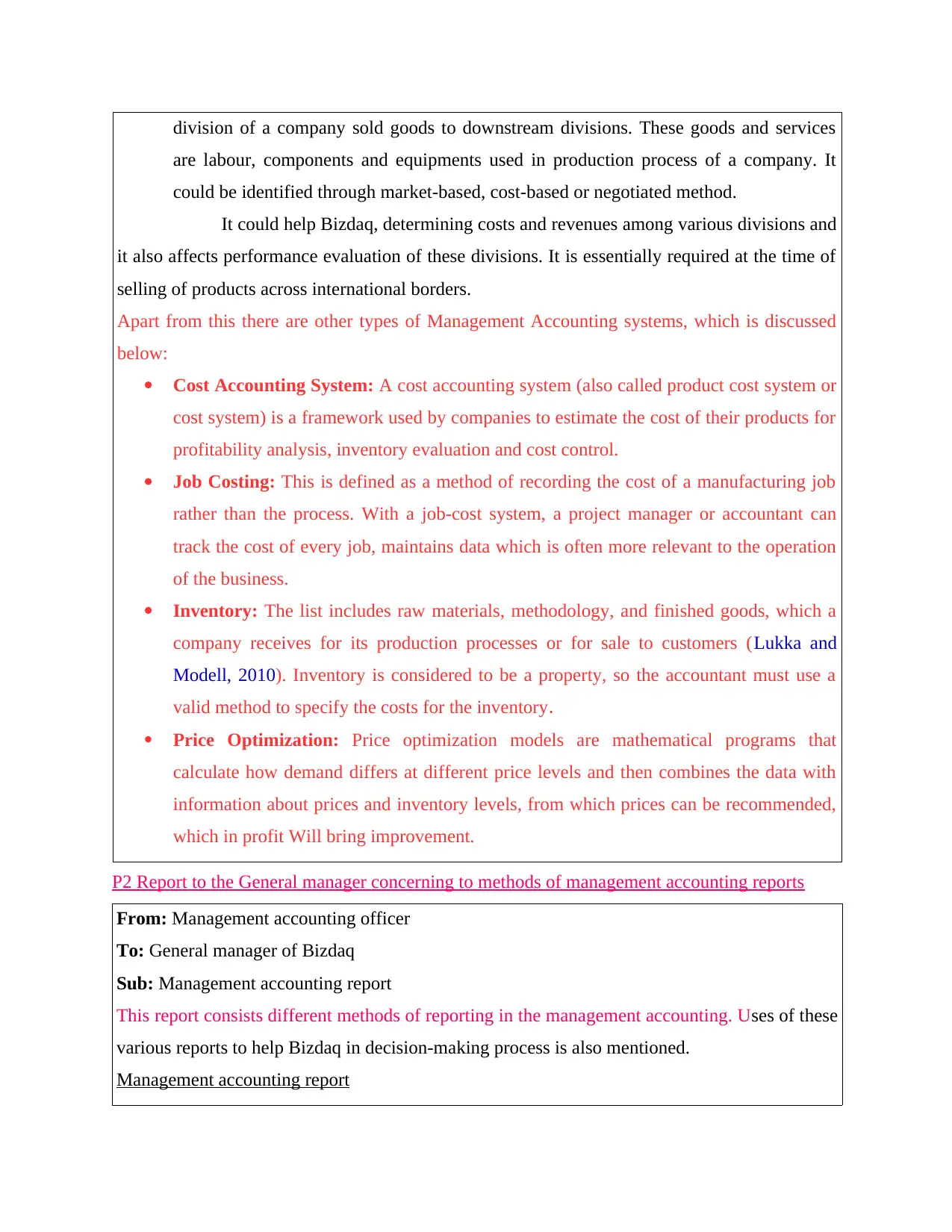
division of a company sold goods to downstream divisions. These goods and services
are labour, components and equipments used in production process of a company. It
could be identified through market-based, cost-based or negotiated method.
It could help Bizdaq, determining costs and revenues among various divisions and
it also affects performance evaluation of these divisions. It is essentially required at the time of
selling of products across international borders.
Apart from this there are other types of Management Accounting systems, which is discussed
below:
Cost Accounting System: A cost accounting system (also called product cost system or
cost system) is a framework used by companies to estimate the cost of their products for
profitability analysis, inventory evaluation and cost control.
Job Costing: This is defined as a method of recording the cost of a manufacturing job
rather than the process. With a job-cost system, a project manager or accountant can
track the cost of every job, maintains data which is often more relevant to the operation
of the business.
Inventory: The list includes raw materials, methodology, and finished goods, which a
company receives for its production processes or for sale to customers (Lukka and
Modell, 2010). Inventory is considered to be a property, so the accountant must use a
valid method to specify the costs for the inventory.
Price Optimization: Price optimization models are mathematical programs that
calculate how demand differs at different price levels and then combines the data with
information about prices and inventory levels, from which prices can be recommended,
which in profit Will bring improvement.
P2 Report to the General manager concerning to methods of management accounting reports
From: Management accounting officer
To: General manager of Bizdaq
Sub: Management accounting report
This report consists different methods of reporting in the management accounting. Uses of these
various reports to help Bizdaq in decision-making process is also mentioned.
Management accounting report
are labour, components and equipments used in production process of a company. It
could be identified through market-based, cost-based or negotiated method.
It could help Bizdaq, determining costs and revenues among various divisions and
it also affects performance evaluation of these divisions. It is essentially required at the time of
selling of products across international borders.
Apart from this there are other types of Management Accounting systems, which is discussed
below:
Cost Accounting System: A cost accounting system (also called product cost system or
cost system) is a framework used by companies to estimate the cost of their products for
profitability analysis, inventory evaluation and cost control.
Job Costing: This is defined as a method of recording the cost of a manufacturing job
rather than the process. With a job-cost system, a project manager or accountant can
track the cost of every job, maintains data which is often more relevant to the operation
of the business.
Inventory: The list includes raw materials, methodology, and finished goods, which a
company receives for its production processes or for sale to customers (Lukka and
Modell, 2010). Inventory is considered to be a property, so the accountant must use a
valid method to specify the costs for the inventory.
Price Optimization: Price optimization models are mathematical programs that
calculate how demand differs at different price levels and then combines the data with
information about prices and inventory levels, from which prices can be recommended,
which in profit Will bring improvement.
P2 Report to the General manager concerning to methods of management accounting reports
From: Management accounting officer
To: General manager of Bizdaq
Sub: Management accounting report
This report consists different methods of reporting in the management accounting. Uses of these
various reports to help Bizdaq in decision-making process is also mentioned.
Management accounting report
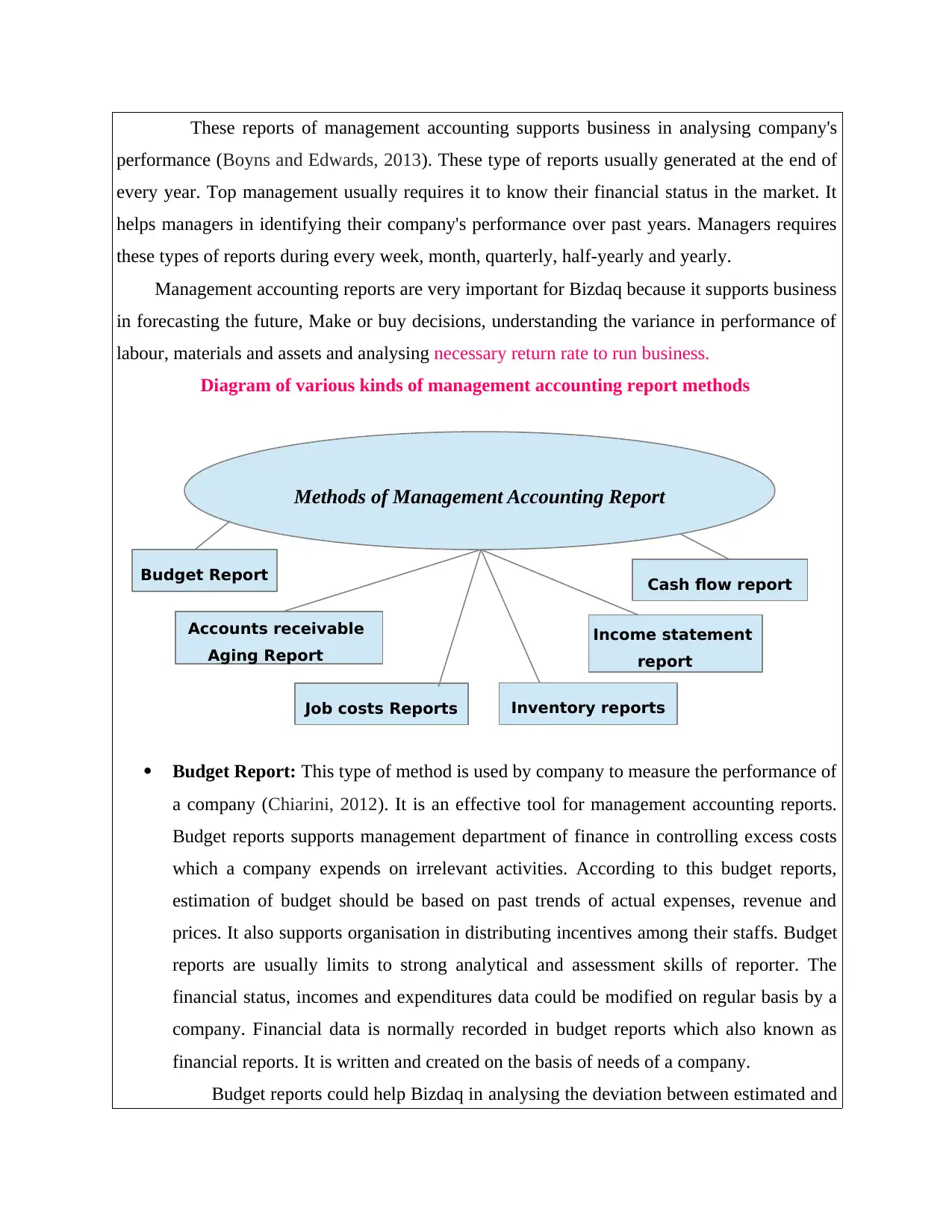
These reports of management accounting supports business in analysing company's
performance (Boyns and Edwards, 2013). These type of reports usually generated at the end of
every year. Top management usually requires it to know their financial status in the market. It
helps managers in identifying their company's performance over past years. Managers requires
these types of reports during every week, month, quarterly, half-yearly and yearly.
Management accounting reports are very important for Bizdaq because it supports business
in forecasting the future, Make or buy decisions, understanding the variance in performance of
labour, materials and assets and analysing necessary return rate to run business.
Diagram of various kinds of management accounting report methods
Budget Report: This type of method is used by company to measure the performance of
a company (Chiarini, 2012). It is an effective tool for management accounting reports.
Budget reports supports management department of finance in controlling excess costs
which a company expends on irrelevant activities. According to this budget reports,
estimation of budget should be based on past trends of actual expenses, revenue and
prices. It also supports organisation in distributing incentives among their staffs. Budget
reports are usually limits to strong analytical and assessment skills of reporter. The
financial status, incomes and expenditures data could be modified on regular basis by a
company. Financial data is normally recorded in budget reports which also known as
financial reports. It is written and created on the basis of needs of a company.
Budget reports could help Bizdaq in analysing the deviation between estimated and
Methods of Management Accounting Report
Accounts receivable
Aging Report
Job costs Reports
Income statement
report
Cash flow report
Budget Report
Inventory reports
performance (Boyns and Edwards, 2013). These type of reports usually generated at the end of
every year. Top management usually requires it to know their financial status in the market. It
helps managers in identifying their company's performance over past years. Managers requires
these types of reports during every week, month, quarterly, half-yearly and yearly.
Management accounting reports are very important for Bizdaq because it supports business
in forecasting the future, Make or buy decisions, understanding the variance in performance of
labour, materials and assets and analysing necessary return rate to run business.
Diagram of various kinds of management accounting report methods
Budget Report: This type of method is used by company to measure the performance of
a company (Chiarini, 2012). It is an effective tool for management accounting reports.
Budget reports supports management department of finance in controlling excess costs
which a company expends on irrelevant activities. According to this budget reports,
estimation of budget should be based on past trends of actual expenses, revenue and
prices. It also supports organisation in distributing incentives among their staffs. Budget
reports are usually limits to strong analytical and assessment skills of reporter. The
financial status, incomes and expenditures data could be modified on regular basis by a
company. Financial data is normally recorded in budget reports which also known as
financial reports. It is written and created on the basis of needs of a company.
Budget reports could help Bizdaq in analysing the deviation between estimated and
Methods of Management Accounting Report
Accounts receivable
Aging Report
Job costs Reports
Income statement
report
Cash flow report
Budget Report
Inventory reports
Paraphrase This Document
Need a fresh take? Get an instant paraphrase of this document with our AI Paraphraser
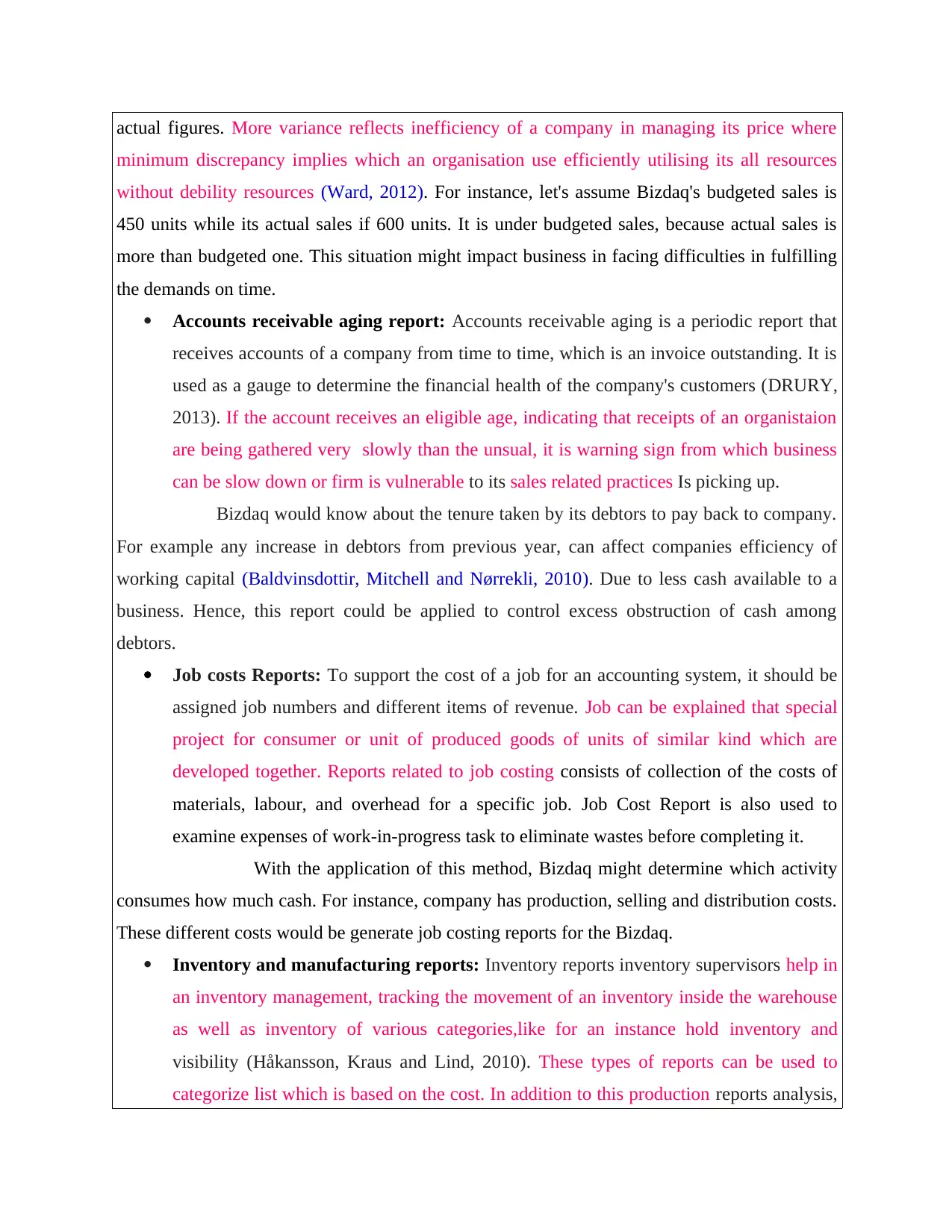
actual figures. More variance reflects inefficiency of a company in managing its price where
minimum discrepancy implies which an organisation use efficiently utilising its all resources
without debility resources (Ward, 2012). For instance, let's assume Bizdaq's budgeted sales is
450 units while its actual sales if 600 units. It is under budgeted sales, because actual sales is
more than budgeted one. This situation might impact business in facing difficulties in fulfilling
the demands on time.
Accounts receivable aging report: Accounts receivable aging is a periodic report that
receives accounts of a company from time to time, which is an invoice outstanding. It is
used as a gauge to determine the financial health of the company's customers (DRURY,
2013). If the account receives an eligible age, indicating that receipts of an organistaion
are being gathered very slowly than the unsual, it is warning sign from which business
can be slow down or firm is vulnerable to its sales related practices Is picking up.
Bizdaq would know about the tenure taken by its debtors to pay back to company.
For example any increase in debtors from previous year, can affect companies efficiency of
working capital (Baldvinsdottir, Mitchell and Nørrekli, 2010). Due to less cash available to a
business. Hence, this report could be applied to control excess obstruction of cash among
debtors.
Job costs Reports: To support the cost of a job for an accounting system, it should be
assigned job numbers and different items of revenue. Job can be explained that special
project for consumer or unit of produced goods of units of similar kind which are
developed together. Reports related to job costing consists of collection of the costs of
materials, labour, and overhead for a specific job. Job Cost Report is also used to
examine expenses of work-in-progress task to eliminate wastes before completing it.
With the application of this method, Bizdaq might determine which activity
consumes how much cash. For instance, company has production, selling and distribution costs.
These different costs would be generate job costing reports for the Bizdaq.
Inventory and manufacturing reports: Inventory reports inventory supervisors help in
an inventory management, tracking the movement of an inventory inside the warehouse
as well as inventory of various categories,like for an instance hold inventory and
visibility (Håkansson, Kraus and Lind, 2010). These types of reports can be used to
categorize list which is based on the cost. In addition to this production reports analysis,
minimum discrepancy implies which an organisation use efficiently utilising its all resources
without debility resources (Ward, 2012). For instance, let's assume Bizdaq's budgeted sales is
450 units while its actual sales if 600 units. It is under budgeted sales, because actual sales is
more than budgeted one. This situation might impact business in facing difficulties in fulfilling
the demands on time.
Accounts receivable aging report: Accounts receivable aging is a periodic report that
receives accounts of a company from time to time, which is an invoice outstanding. It is
used as a gauge to determine the financial health of the company's customers (DRURY,
2013). If the account receives an eligible age, indicating that receipts of an organistaion
are being gathered very slowly than the unsual, it is warning sign from which business
can be slow down or firm is vulnerable to its sales related practices Is picking up.
Bizdaq would know about the tenure taken by its debtors to pay back to company.
For example any increase in debtors from previous year, can affect companies efficiency of
working capital (Baldvinsdottir, Mitchell and Nørrekli, 2010). Due to less cash available to a
business. Hence, this report could be applied to control excess obstruction of cash among
debtors.
Job costs Reports: To support the cost of a job for an accounting system, it should be
assigned job numbers and different items of revenue. Job can be explained that special
project for consumer or unit of produced goods of units of similar kind which are
developed together. Reports related to job costing consists of collection of the costs of
materials, labour, and overhead for a specific job. Job Cost Report is also used to
examine expenses of work-in-progress task to eliminate wastes before completing it.
With the application of this method, Bizdaq might determine which activity
consumes how much cash. For instance, company has production, selling and distribution costs.
These different costs would be generate job costing reports for the Bizdaq.
Inventory and manufacturing reports: Inventory reports inventory supervisors help in
an inventory management, tracking the movement of an inventory inside the warehouse
as well as inventory of various categories,like for an instance hold inventory and
visibility (Håkansson, Kraus and Lind, 2010). These types of reports can be used to
categorize list which is based on the cost. In addition to this production reports analysis,
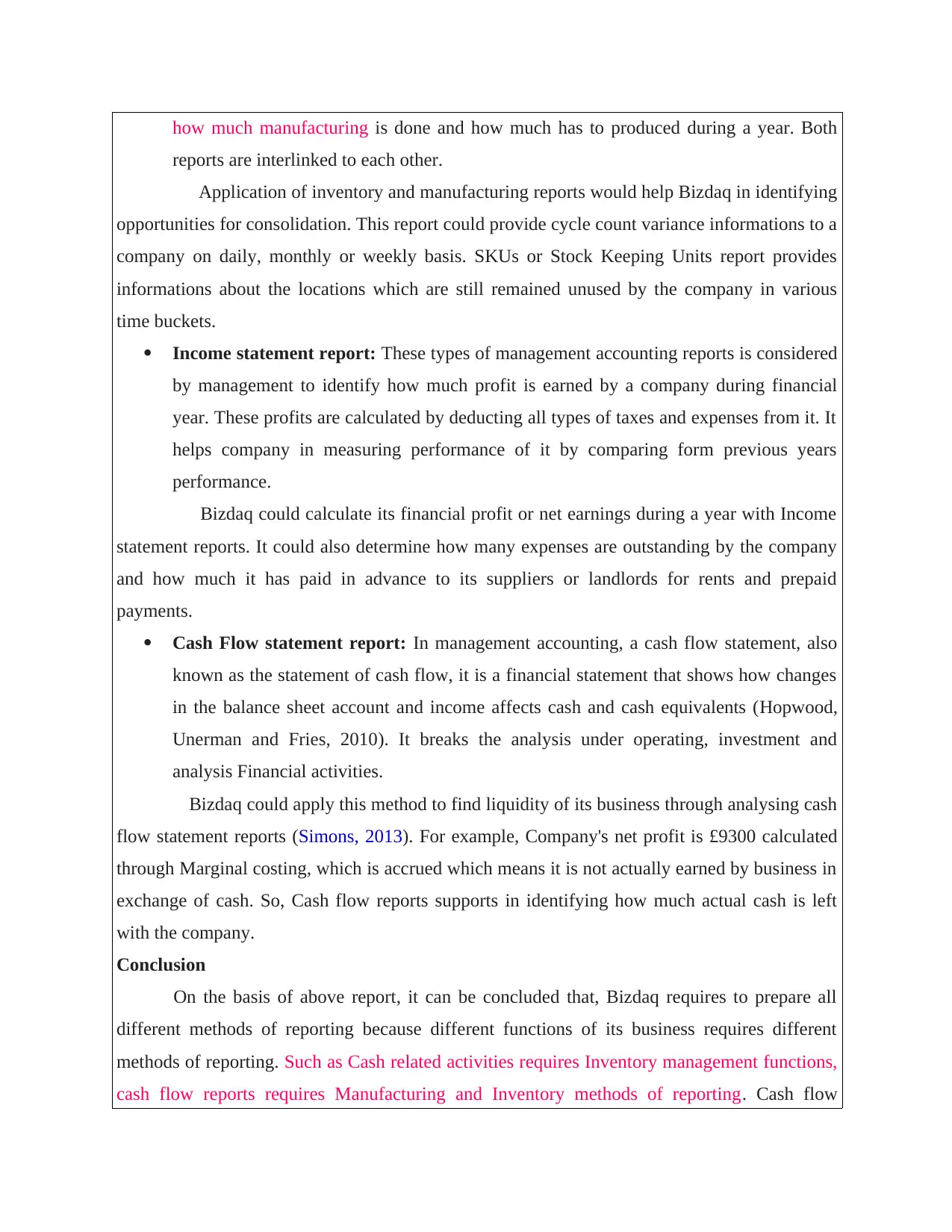
how much manufacturing is done and how much has to produced during a year. Both
reports are interlinked to each other.
Application of inventory and manufacturing reports would help Bizdaq in identifying
opportunities for consolidation. This report could provide cycle count variance informations to a
company on daily, monthly or weekly basis. SKUs or Stock Keeping Units report provides
informations about the locations which are still remained unused by the company in various
time buckets.
Income statement report: These types of management accounting reports is considered
by management to identify how much profit is earned by a company during financial
year. These profits are calculated by deducting all types of taxes and expenses from it. It
helps company in measuring performance of it by comparing form previous years
performance.
Bizdaq could calculate its financial profit or net earnings during a year with Income
statement reports. It could also determine how many expenses are outstanding by the company
and how much it has paid in advance to its suppliers or landlords for rents and prepaid
payments.
Cash Flow statement report: In management accounting, a cash flow statement, also
known as the statement of cash flow, it is a financial statement that shows how changes
in the balance sheet account and income affects cash and cash equivalents (Hopwood,
Unerman and Fries, 2010). It breaks the analysis under operating, investment and
analysis Financial activities.
Bizdaq could apply this method to find liquidity of its business through analysing cash
flow statement reports (Simons, 2013). For example, Company's net profit is £9300 calculated
through Marginal costing, which is accrued which means it is not actually earned by business in
exchange of cash. So, Cash flow reports supports in identifying how much actual cash is left
with the company.
Conclusion
On the basis of above report, it can be concluded that, Bizdaq requires to prepare all
different methods of reporting because different functions of its business requires different
methods of reporting. Such as Cash related activities requires Inventory management functions,
cash flow reports requires Manufacturing and Inventory methods of reporting. Cash flow
reports are interlinked to each other.
Application of inventory and manufacturing reports would help Bizdaq in identifying
opportunities for consolidation. This report could provide cycle count variance informations to a
company on daily, monthly or weekly basis. SKUs or Stock Keeping Units report provides
informations about the locations which are still remained unused by the company in various
time buckets.
Income statement report: These types of management accounting reports is considered
by management to identify how much profit is earned by a company during financial
year. These profits are calculated by deducting all types of taxes and expenses from it. It
helps company in measuring performance of it by comparing form previous years
performance.
Bizdaq could calculate its financial profit or net earnings during a year with Income
statement reports. It could also determine how many expenses are outstanding by the company
and how much it has paid in advance to its suppliers or landlords for rents and prepaid
payments.
Cash Flow statement report: In management accounting, a cash flow statement, also
known as the statement of cash flow, it is a financial statement that shows how changes
in the balance sheet account and income affects cash and cash equivalents (Hopwood,
Unerman and Fries, 2010). It breaks the analysis under operating, investment and
analysis Financial activities.
Bizdaq could apply this method to find liquidity of its business through analysing cash
flow statement reports (Simons, 2013). For example, Company's net profit is £9300 calculated
through Marginal costing, which is accrued which means it is not actually earned by business in
exchange of cash. So, Cash flow reports supports in identifying how much actual cash is left
with the company.
Conclusion
On the basis of above report, it can be concluded that, Bizdaq requires to prepare all
different methods of reporting because different functions of its business requires different
methods of reporting. Such as Cash related activities requires Inventory management functions,
cash flow reports requires Manufacturing and Inventory methods of reporting. Cash flow
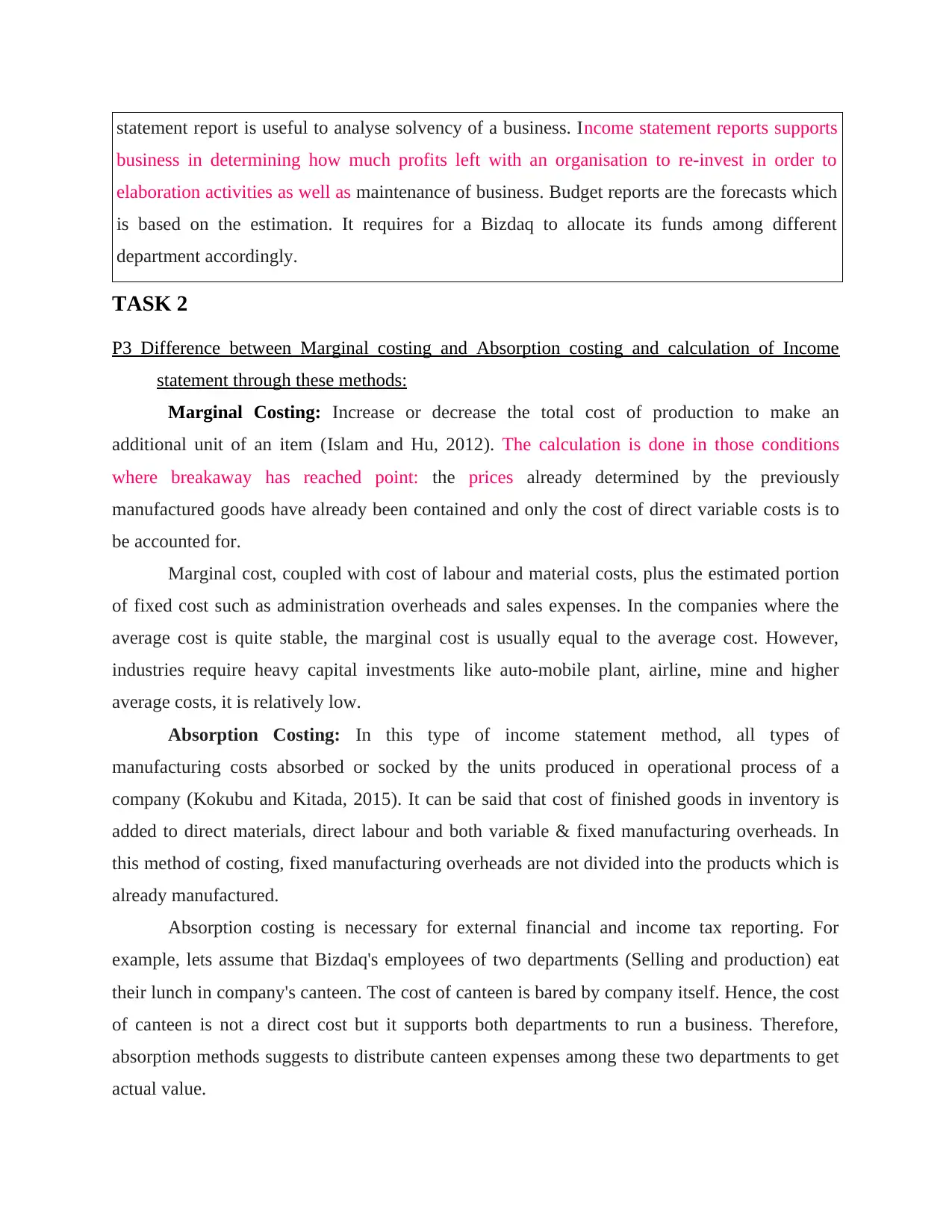
statement report is useful to analyse solvency of a business. Income statement reports supports
business in determining how much profits left with an organisation to re-invest in order to
elaboration activities as well as maintenance of business. Budget reports are the forecasts which
is based on the estimation. It requires for a Bizdaq to allocate its funds among different
department accordingly.
TASK 2
P3 Difference between Marginal costing and Absorption costing and calculation of Income
statement through these methods:
Marginal Costing: Increase or decrease the total cost of production to make an
additional unit of an item (Islam and Hu, 2012). The calculation is done in those conditions
where breakaway has reached point: the prices already determined by the previously
manufactured goods have already been contained and only the cost of direct variable costs is to
be accounted for.
Marginal cost, coupled with cost of labour and material costs, plus the estimated portion
of fixed cost such as administration overheads and sales expenses. In the companies where the
average cost is quite stable, the marginal cost is usually equal to the average cost. However,
industries require heavy capital investments like auto-mobile plant, airline, mine and higher
average costs, it is relatively low.
Absorption Costing: In this type of income statement method, all types of
manufacturing costs absorbed or socked by the units produced in operational process of a
company (Kokubu and Kitada, 2015). It can be said that cost of finished goods in inventory is
added to direct materials, direct labour and both variable & fixed manufacturing overheads. In
this method of costing, fixed manufacturing overheads are not divided into the products which is
already manufactured.
Absorption costing is necessary for external financial and income tax reporting. For
example, lets assume that Bizdaq's employees of two departments (Selling and production) eat
their lunch in company's canteen. The cost of canteen is bared by company itself. Hence, the cost
of canteen is not a direct cost but it supports both departments to run a business. Therefore,
absorption methods suggests to distribute canteen expenses among these two departments to get
actual value.
business in determining how much profits left with an organisation to re-invest in order to
elaboration activities as well as maintenance of business. Budget reports are the forecasts which
is based on the estimation. It requires for a Bizdaq to allocate its funds among different
department accordingly.
TASK 2
P3 Difference between Marginal costing and Absorption costing and calculation of Income
statement through these methods:
Marginal Costing: Increase or decrease the total cost of production to make an
additional unit of an item (Islam and Hu, 2012). The calculation is done in those conditions
where breakaway has reached point: the prices already determined by the previously
manufactured goods have already been contained and only the cost of direct variable costs is to
be accounted for.
Marginal cost, coupled with cost of labour and material costs, plus the estimated portion
of fixed cost such as administration overheads and sales expenses. In the companies where the
average cost is quite stable, the marginal cost is usually equal to the average cost. However,
industries require heavy capital investments like auto-mobile plant, airline, mine and higher
average costs, it is relatively low.
Absorption Costing: In this type of income statement method, all types of
manufacturing costs absorbed or socked by the units produced in operational process of a
company (Kokubu and Kitada, 2015). It can be said that cost of finished goods in inventory is
added to direct materials, direct labour and both variable & fixed manufacturing overheads. In
this method of costing, fixed manufacturing overheads are not divided into the products which is
already manufactured.
Absorption costing is necessary for external financial and income tax reporting. For
example, lets assume that Bizdaq's employees of two departments (Selling and production) eat
their lunch in company's canteen. The cost of canteen is bared by company itself. Hence, the cost
of canteen is not a direct cost but it supports both departments to run a business. Therefore,
absorption methods suggests to distribute canteen expenses among these two departments to get
actual value.
Secure Best Marks with AI Grader
Need help grading? Try our AI Grader for instant feedback on your assignments.
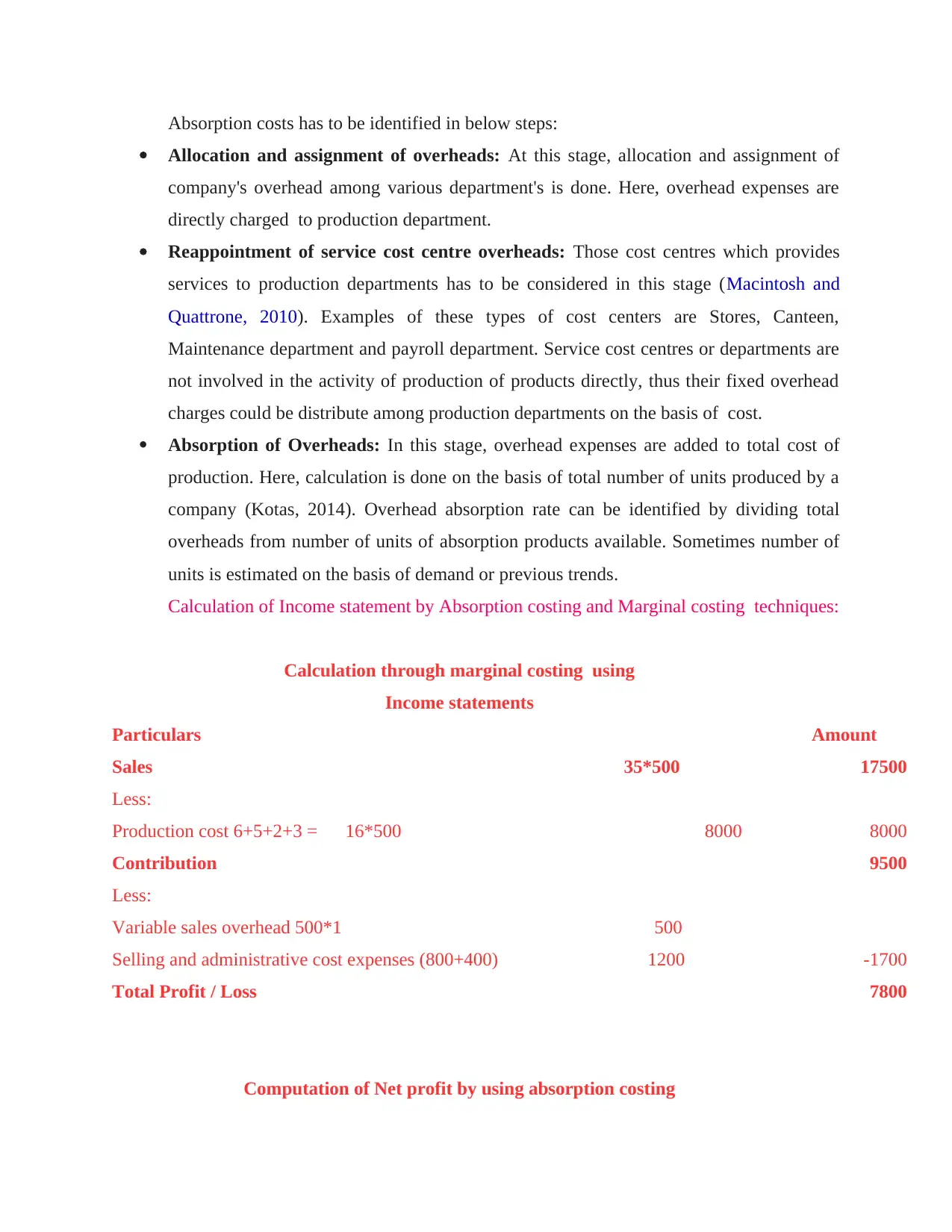
Absorption costs has to be identified in below steps:
Allocation and assignment of overheads: At this stage, allocation and assignment of
company's overhead among various department's is done. Here, overhead expenses are
directly charged to production department.
Reappointment of service cost centre overheads: Those cost centres which provides
services to production departments has to be considered in this stage (Macintosh and
Quattrone, 2010). Examples of these types of cost centers are Stores, Canteen,
Maintenance department and payroll department. Service cost centres or departments are
not involved in the activity of production of products directly, thus their fixed overhead
charges could be distribute among production departments on the basis of cost.
Absorption of Overheads: In this stage, overhead expenses are added to total cost of
production. Here, calculation is done on the basis of total number of units produced by a
company (Kotas, 2014). Overhead absorption rate can be identified by dividing total
overheads from number of units of absorption products available. Sometimes number of
units is estimated on the basis of demand or previous trends.
Calculation of Income statement by Absorption costing and Marginal costing techniques:
Calculation through marginal costing using
Income statements
Particulars Amount
Sales 35*500 17500
Less:
Production cost 6+5+2+3 = 16*500 8000 8000
Contribution 9500
Less:
Variable sales overhead 500*1 500
Selling and administrative cost expenses (800+400) 1200 -1700
Total Profit / Loss 7800
Computation of Net profit by using absorption costing
Allocation and assignment of overheads: At this stage, allocation and assignment of
company's overhead among various department's is done. Here, overhead expenses are
directly charged to production department.
Reappointment of service cost centre overheads: Those cost centres which provides
services to production departments has to be considered in this stage (Macintosh and
Quattrone, 2010). Examples of these types of cost centers are Stores, Canteen,
Maintenance department and payroll department. Service cost centres or departments are
not involved in the activity of production of products directly, thus their fixed overhead
charges could be distribute among production departments on the basis of cost.
Absorption of Overheads: In this stage, overhead expenses are added to total cost of
production. Here, calculation is done on the basis of total number of units produced by a
company (Kotas, 2014). Overhead absorption rate can be identified by dividing total
overheads from number of units of absorption products available. Sometimes number of
units is estimated on the basis of demand or previous trends.
Calculation of Income statement by Absorption costing and Marginal costing techniques:
Calculation through marginal costing using
Income statements
Particulars Amount
Sales 35*500 17500
Less:
Production cost 6+5+2+3 = 16*500 8000 8000
Contribution 9500
Less:
Variable sales overhead 500*1 500
Selling and administrative cost expenses (800+400) 1200 -1700
Total Profit / Loss 7800
Computation of Net profit by using absorption costing
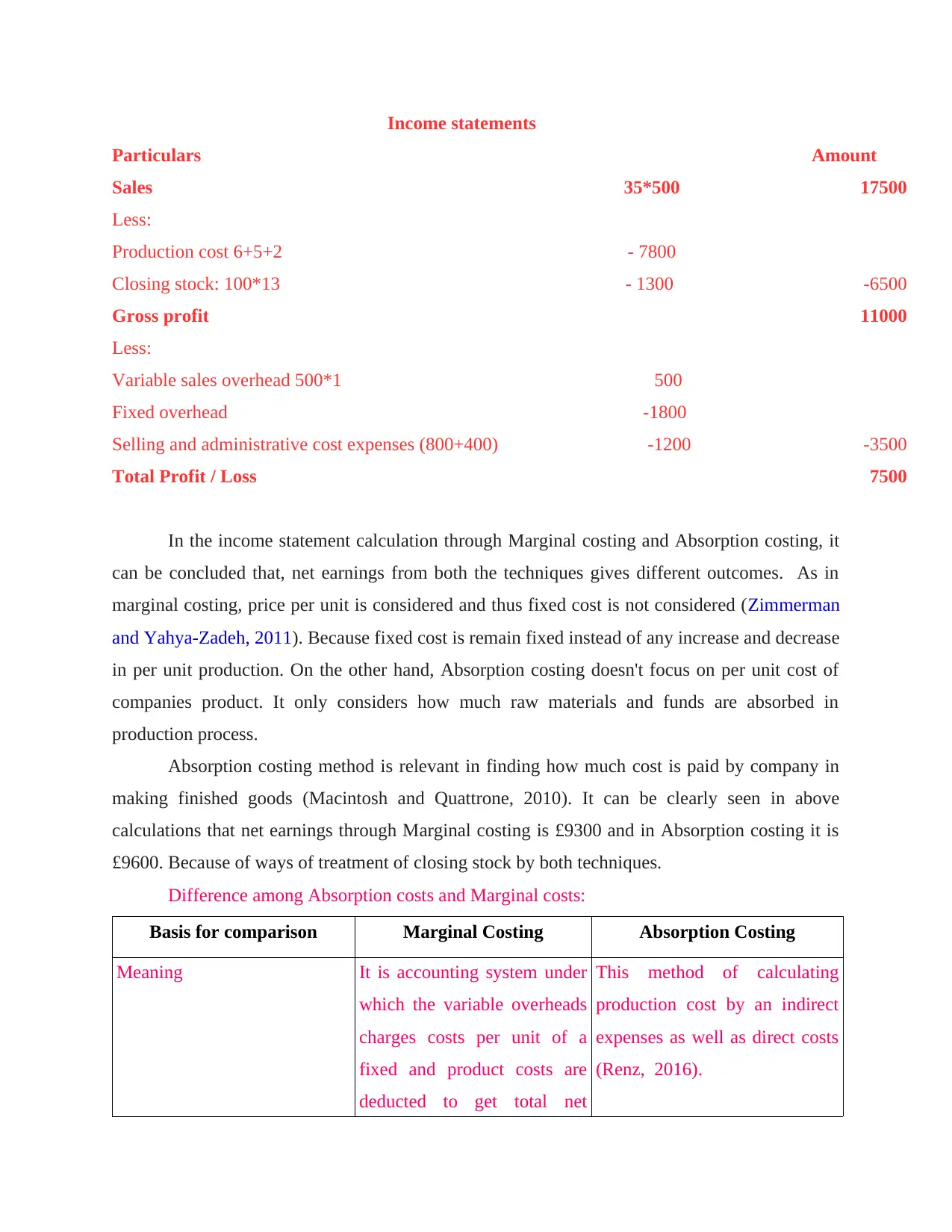
Income statements
Particulars Amount
Sales 35*500 17500
Less:
Production cost 6+5+2 - 7800
Closing stock: 100*13 - 1300 -6500
Gross profit 11000
Less:
Variable sales overhead 500*1 500
Fixed overhead -1800
Selling and administrative cost expenses (800+400) -1200 -3500
Total Profit / Loss 7500
In the income statement calculation through Marginal costing and Absorption costing, it
can be concluded that, net earnings from both the techniques gives different outcomes. As in
marginal costing, price per unit is considered and thus fixed cost is not considered (Zimmerman
and Yahya-Zadeh, 2011). Because fixed cost is remain fixed instead of any increase and decrease
in per unit production. On the other hand, Absorption costing doesn't focus on per unit cost of
companies product. It only considers how much raw materials and funds are absorbed in
production process.
Absorption costing method is relevant in finding how much cost is paid by company in
making finished goods (Macintosh and Quattrone, 2010). It can be clearly seen in above
calculations that net earnings through Marginal costing is £9300 and in Absorption costing it is
£9600. Because of ways of treatment of closing stock by both techniques.
Difference among Absorption costs and Marginal costs:
Basis for comparison Marginal Costing Absorption Costing
Meaning It is accounting system under
which the variable overheads
charges costs per unit of a
fixed and product costs are
deducted to get total net
This method of calculating
production cost by an indirect
expenses as well as direct costs
(Renz, 2016).
Particulars Amount
Sales 35*500 17500
Less:
Production cost 6+5+2 - 7800
Closing stock: 100*13 - 1300 -6500
Gross profit 11000
Less:
Variable sales overhead 500*1 500
Fixed overhead -1800
Selling and administrative cost expenses (800+400) -1200 -3500
Total Profit / Loss 7500
In the income statement calculation through Marginal costing and Absorption costing, it
can be concluded that, net earnings from both the techniques gives different outcomes. As in
marginal costing, price per unit is considered and thus fixed cost is not considered (Zimmerman
and Yahya-Zadeh, 2011). Because fixed cost is remain fixed instead of any increase and decrease
in per unit production. On the other hand, Absorption costing doesn't focus on per unit cost of
companies product. It only considers how much raw materials and funds are absorbed in
production process.
Absorption costing method is relevant in finding how much cost is paid by company in
making finished goods (Macintosh and Quattrone, 2010). It can be clearly seen in above
calculations that net earnings through Marginal costing is £9300 and in Absorption costing it is
£9600. Because of ways of treatment of closing stock by both techniques.
Difference among Absorption costs and Marginal costs:
Basis for comparison Marginal Costing Absorption Costing
Meaning It is accounting system under
which the variable overheads
charges costs per unit of a
fixed and product costs are
deducted to get total net
This method of calculating
production cost by an indirect
expenses as well as direct costs
(Renz, 2016).
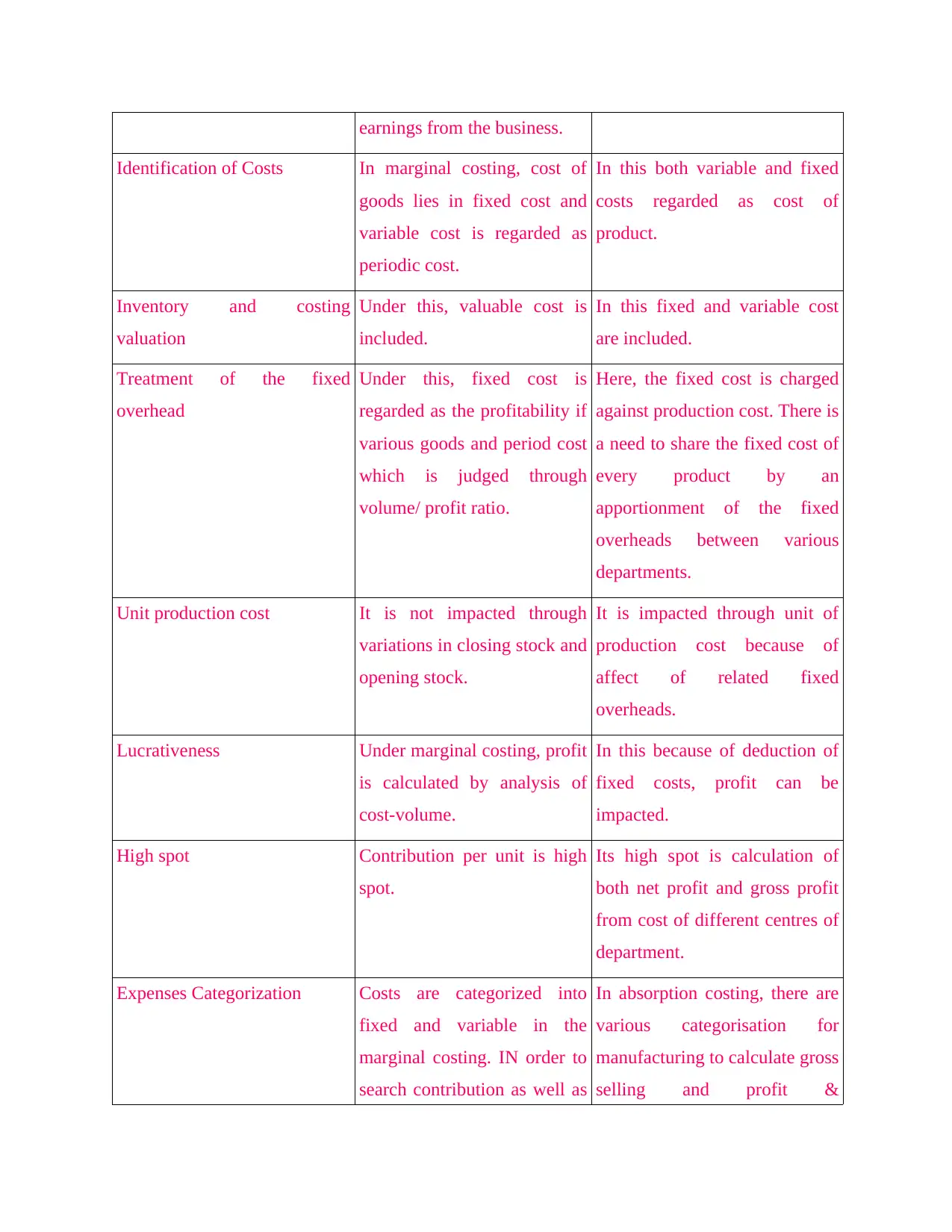
earnings from the business.
Identification of Costs In marginal costing, cost of
goods lies in fixed cost and
variable cost is regarded as
periodic cost.
In this both variable and fixed
costs regarded as cost of
product.
Inventory and costing
valuation
Under this, valuable cost is
included.
In this fixed and variable cost
are included.
Treatment of the fixed
overhead
Under this, fixed cost is
regarded as the profitability if
various goods and period cost
which is judged through
volume/ profit ratio.
Here, the fixed cost is charged
against production cost. There is
a need to share the fixed cost of
every product by an
apportionment of the fixed
overheads between various
departments.
Unit production cost It is not impacted through
variations in closing stock and
opening stock.
It is impacted through unit of
production cost because of
affect of related fixed
overheads.
Lucrativeness Under marginal costing, profit
is calculated by analysis of
cost-volume.
In this because of deduction of
fixed costs, profit can be
impacted.
High spot Contribution per unit is high
spot.
Its high spot is calculation of
both net profit and gross profit
from cost of different centres of
department.
Expenses Categorization Costs are categorized into
fixed and variable in the
marginal costing. IN order to
search contribution as well as
In absorption costing, there are
various categorisation for
manufacturing to calculate gross
selling and profit &
Identification of Costs In marginal costing, cost of
goods lies in fixed cost and
variable cost is regarded as
periodic cost.
In this both variable and fixed
costs regarded as cost of
product.
Inventory and costing
valuation
Under this, valuable cost is
included.
In this fixed and variable cost
are included.
Treatment of the fixed
overhead
Under this, fixed cost is
regarded as the profitability if
various goods and period cost
which is judged through
volume/ profit ratio.
Here, the fixed cost is charged
against production cost. There is
a need to share the fixed cost of
every product by an
apportionment of the fixed
overheads between various
departments.
Unit production cost It is not impacted through
variations in closing stock and
opening stock.
It is impacted through unit of
production cost because of
affect of related fixed
overheads.
Lucrativeness Under marginal costing, profit
is calculated by analysis of
cost-volume.
In this because of deduction of
fixed costs, profit can be
impacted.
High spot Contribution per unit is high
spot.
Its high spot is calculation of
both net profit and gross profit
from cost of different centres of
department.
Expenses Categorization Costs are categorized into
fixed and variable in the
marginal costing. IN order to
search contribution as well as
In absorption costing, there are
various categorisation for
manufacturing to calculate gross
selling and profit &
Paraphrase This Document
Need a fresh take? Get an instant paraphrase of this document with our AI Paraphraser
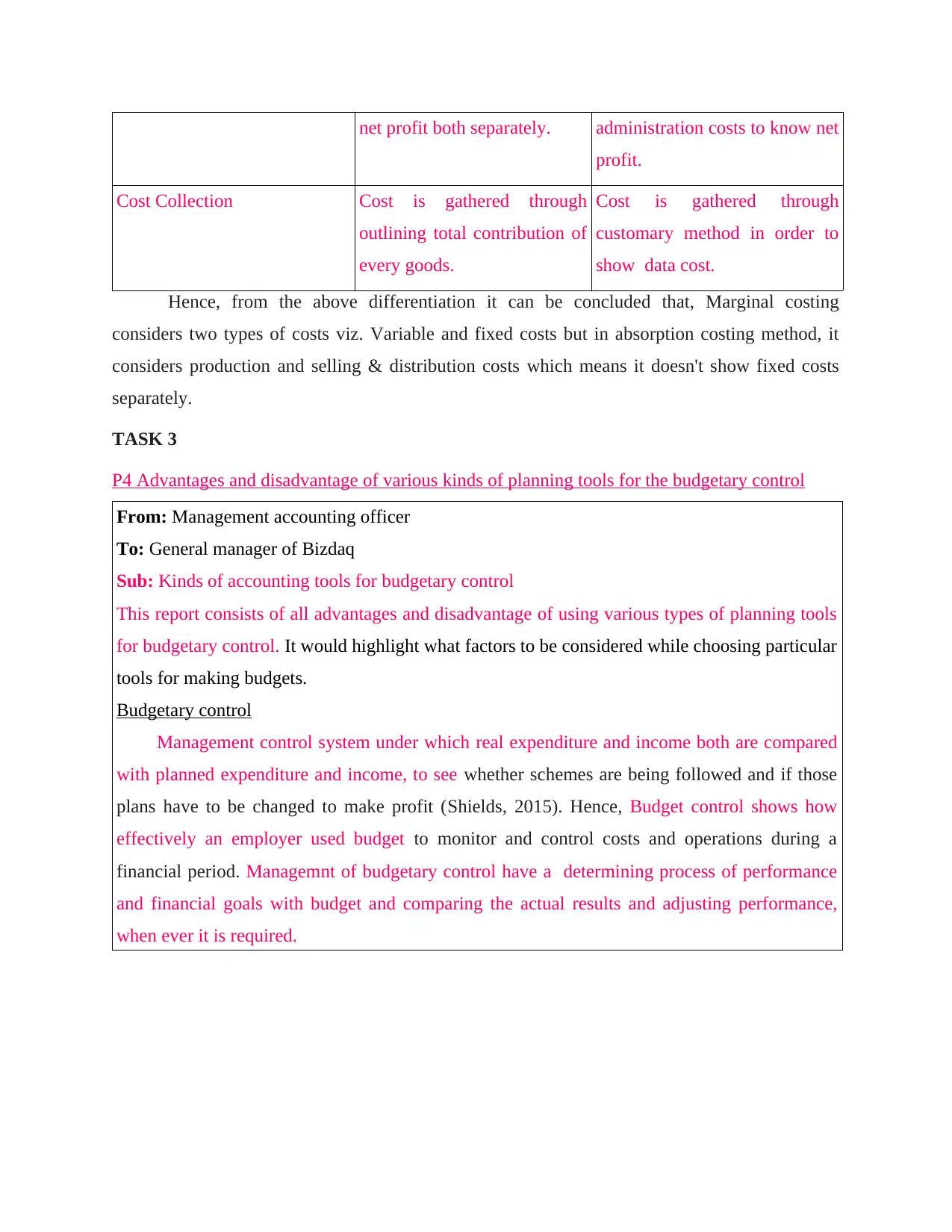
net profit both separately. administration costs to know net
profit.
Cost Collection Cost is gathered through
outlining total contribution of
every goods.
Cost is gathered through
customary method in order to
show data cost.
Hence, from the above differentiation it can be concluded that, Marginal costing
considers two types of costs viz. Variable and fixed costs but in absorption costing method, it
considers production and selling & distribution costs which means it doesn't show fixed costs
separately.
TASK 3
P4 Advantages and disadvantage of various kinds of planning tools for the budgetary control
From: Management accounting officer
To: General manager of Bizdaq
Sub: Kinds of accounting tools for budgetary control
This report consists of all advantages and disadvantage of using various types of planning tools
for budgetary control. It would highlight what factors to be considered while choosing particular
tools for making budgets.
Budgetary control
Management control system under which real expenditure and income both are compared
with planned expenditure and income, to see whether schemes are being followed and if those
plans have to be changed to make profit (Shields, 2015). Hence, Budget control shows how
effectively an employer used budget to monitor and control costs and operations during a
financial period. Managemnt of budgetary control have a determining process of performance
and financial goals with budget and comparing the actual results and adjusting performance,
when ever it is required.
profit.
Cost Collection Cost is gathered through
outlining total contribution of
every goods.
Cost is gathered through
customary method in order to
show data cost.
Hence, from the above differentiation it can be concluded that, Marginal costing
considers two types of costs viz. Variable and fixed costs but in absorption costing method, it
considers production and selling & distribution costs which means it doesn't show fixed costs
separately.
TASK 3
P4 Advantages and disadvantage of various kinds of planning tools for the budgetary control
From: Management accounting officer
To: General manager of Bizdaq
Sub: Kinds of accounting tools for budgetary control
This report consists of all advantages and disadvantage of using various types of planning tools
for budgetary control. It would highlight what factors to be considered while choosing particular
tools for making budgets.
Budgetary control
Management control system under which real expenditure and income both are compared
with planned expenditure and income, to see whether schemes are being followed and if those
plans have to be changed to make profit (Shields, 2015). Hence, Budget control shows how
effectively an employer used budget to monitor and control costs and operations during a
financial period. Managemnt of budgetary control have a determining process of performance
and financial goals with budget and comparing the actual results and adjusting performance,
when ever it is required.
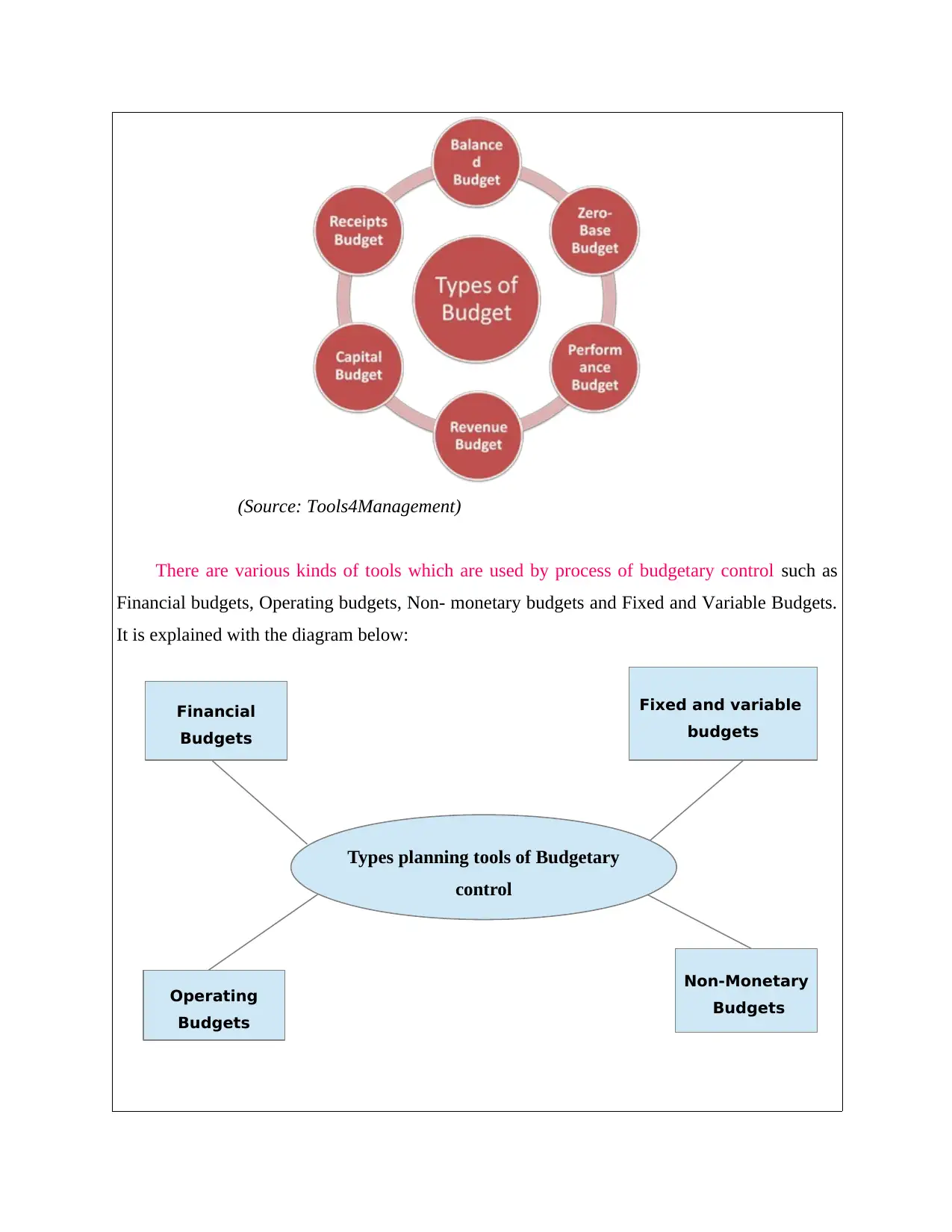
(Source: Tools4Management)
There are various kinds of tools which are used by process of budgetary control such as
Financial budgets, Operating budgets, Non- monetary budgets and Fixed and Variable Budgets.
It is explained with the diagram below:
Types planning tools of Budgetary
control
Financial
Budgets
Non-Monetary
Budgets
Operating
Budgets
Fixed and variable
budgets
There are various kinds of tools which are used by process of budgetary control such as
Financial budgets, Operating budgets, Non- monetary budgets and Fixed and Variable Budgets.
It is explained with the diagram below:
Types planning tools of Budgetary
control
Financial
Budgets
Non-Monetary
Budgets
Operating
Budgets
Fixed and variable
budgets
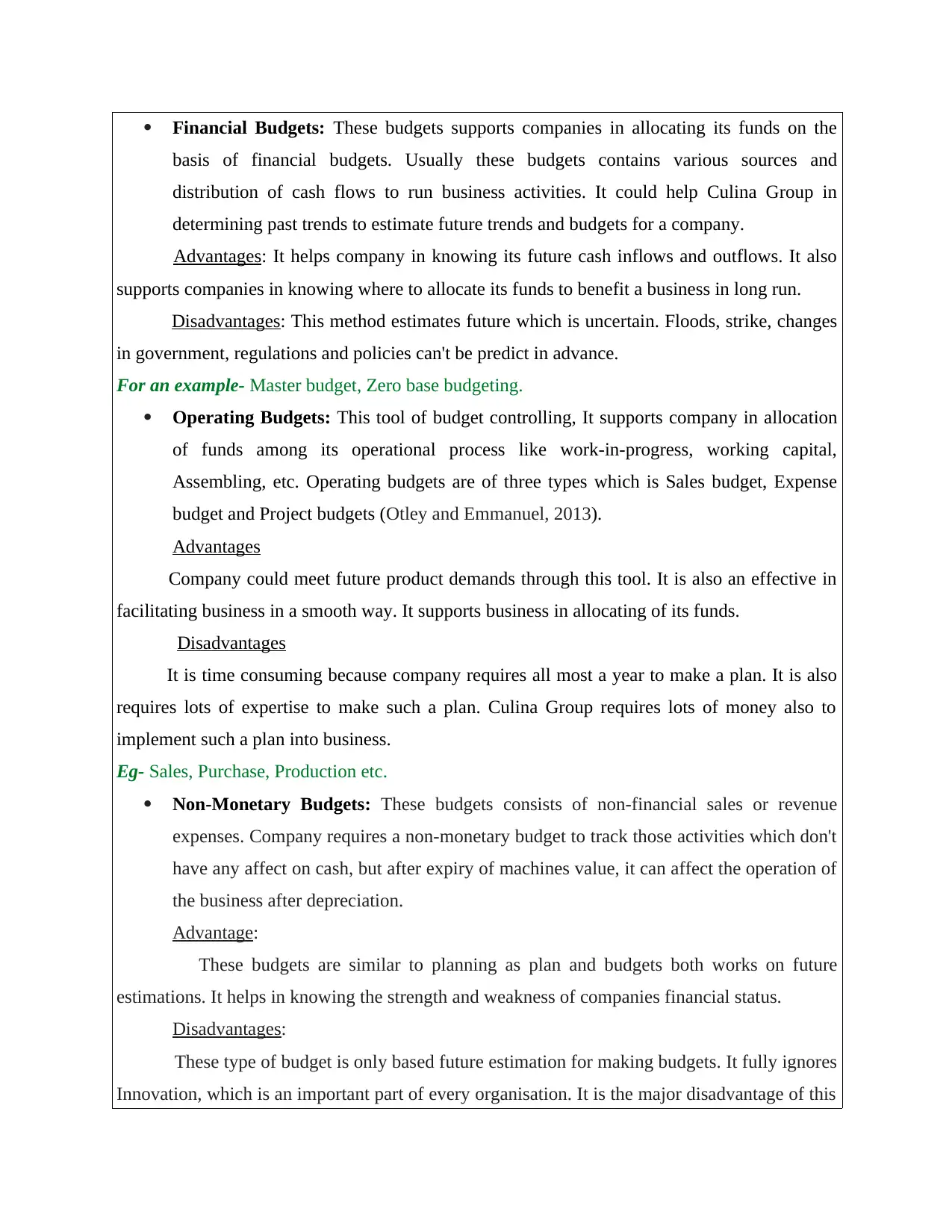
Financial Budgets: These budgets supports companies in allocating its funds on the
basis of financial budgets. Usually these budgets contains various sources and
distribution of cash flows to run business activities. It could help Culina Group in
determining past trends to estimate future trends and budgets for a company.
Advantages: It helps company in knowing its future cash inflows and outflows. It also
supports companies in knowing where to allocate its funds to benefit a business in long run.
Disadvantages: This method estimates future which is uncertain. Floods, strike, changes
in government, regulations and policies can't be predict in advance.
For an example- Master budget, Zero base budgeting.
Operating Budgets: This tool of budget controlling, It supports company in allocation
of funds among its operational process like work-in-progress, working capital,
Assembling, etc. Operating budgets are of three types which is Sales budget, Expense
budget and Project budgets (Otley and Emmanuel, 2013).
Advantages
Company could meet future product demands through this tool. It is also an effective in
facilitating business in a smooth way. It supports business in allocating of its funds.
Disadvantages
It is time consuming because company requires all most a year to make a plan. It is also
requires lots of expertise to make such a plan. Culina Group requires lots of money also to
implement such a plan into business.
Eg- Sales, Purchase, Production etc.
Non-Monetary Budgets: These budgets consists of non-financial sales or revenue
expenses. Company requires a non-monetary budget to track those activities which don't
have any affect on cash, but after expiry of machines value, it can affect the operation of
the business after depreciation.
Advantage:
These budgets are similar to planning as plan and budgets both works on future
estimations. It helps in knowing the strength and weakness of companies financial status.
Disadvantages:
These type of budget is only based future estimation for making budgets. It fully ignores
Innovation, which is an important part of every organisation. It is the major disadvantage of this
basis of financial budgets. Usually these budgets contains various sources and
distribution of cash flows to run business activities. It could help Culina Group in
determining past trends to estimate future trends and budgets for a company.
Advantages: It helps company in knowing its future cash inflows and outflows. It also
supports companies in knowing where to allocate its funds to benefit a business in long run.
Disadvantages: This method estimates future which is uncertain. Floods, strike, changes
in government, regulations and policies can't be predict in advance.
For an example- Master budget, Zero base budgeting.
Operating Budgets: This tool of budget controlling, It supports company in allocation
of funds among its operational process like work-in-progress, working capital,
Assembling, etc. Operating budgets are of three types which is Sales budget, Expense
budget and Project budgets (Otley and Emmanuel, 2013).
Advantages
Company could meet future product demands through this tool. It is also an effective in
facilitating business in a smooth way. It supports business in allocating of its funds.
Disadvantages
It is time consuming because company requires all most a year to make a plan. It is also
requires lots of expertise to make such a plan. Culina Group requires lots of money also to
implement such a plan into business.
Eg- Sales, Purchase, Production etc.
Non-Monetary Budgets: These budgets consists of non-financial sales or revenue
expenses. Company requires a non-monetary budget to track those activities which don't
have any affect on cash, but after expiry of machines value, it can affect the operation of
the business after depreciation.
Advantage:
These budgets are similar to planning as plan and budgets both works on future
estimations. It helps in knowing the strength and weakness of companies financial status.
Disadvantages:
These type of budget is only based future estimation for making budgets. It fully ignores
Innovation, which is an important part of every organisation. It is the major disadvantage of this
Secure Best Marks with AI Grader
Need help grading? Try our AI Grader for instant feedback on your assignments.
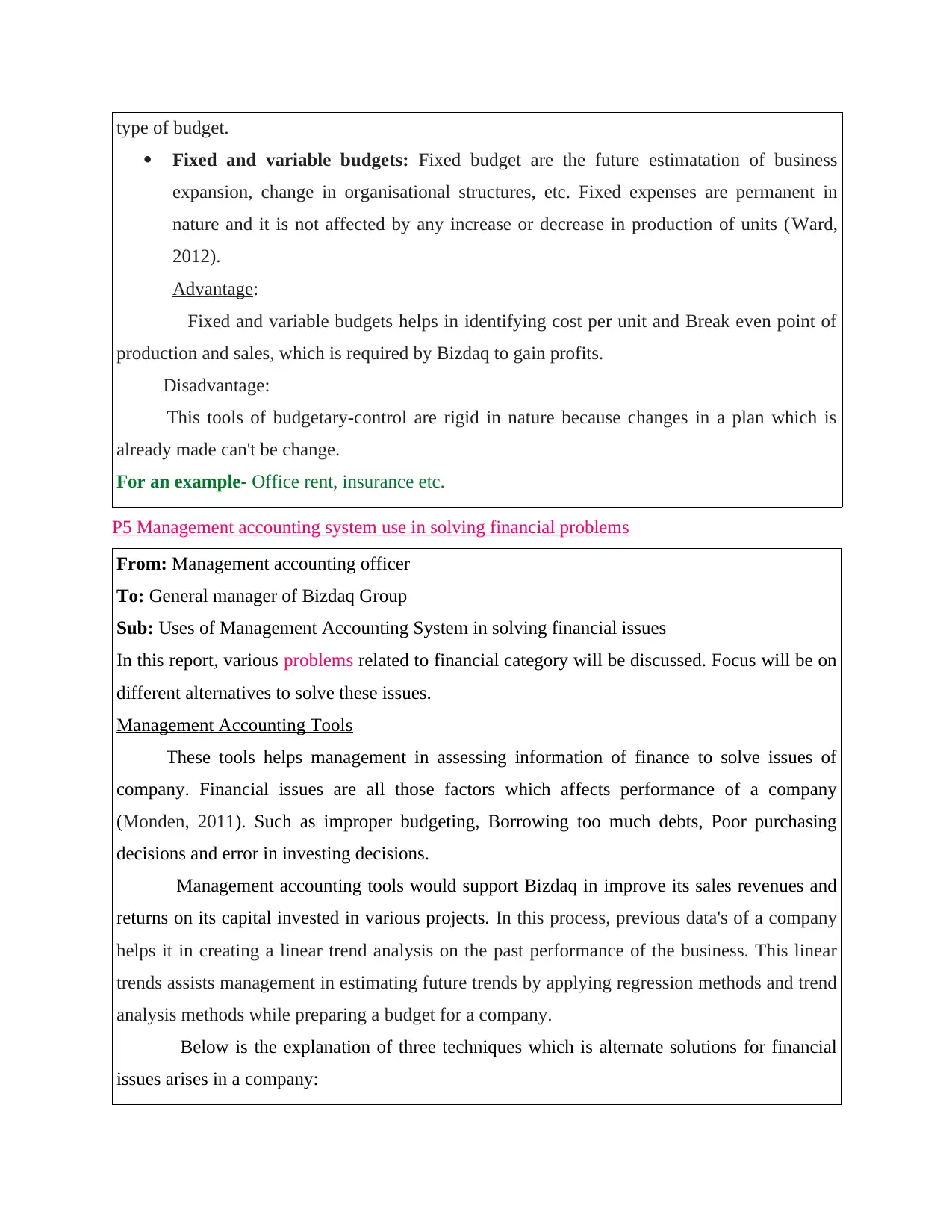
type of budget.
Fixed and variable budgets: Fixed budget are the future estimatation of business
expansion, change in organisational structures, etc. Fixed expenses are permanent in
nature and it is not affected by any increase or decrease in production of units (Ward,
2012).
Advantage:
Fixed and variable budgets helps in identifying cost per unit and Break even point of
production and sales, which is required by Bizdaq to gain profits.
Disadvantage:
This tools of budgetary-control are rigid in nature because changes in a plan which is
already made can't be change.
For an example- Office rent, insurance etc.
P5 Management accounting system use in solving financial problems
From: Management accounting officer
To: General manager of Bizdaq Group
Sub: Uses of Management Accounting System in solving financial issues
In this report, various problems related to financial category will be discussed. Focus will be on
different alternatives to solve these issues.
Management Accounting Tools
These tools helps management in assessing information of finance to solve issues of
company. Financial issues are all those factors which affects performance of a company
(Monden, 2011). Such as improper budgeting, Borrowing too much debts, Poor purchasing
decisions and error in investing decisions.
Management accounting tools would support Bizdaq in improve its sales revenues and
returns on its capital invested in various projects. In this process, previous data's of a company
helps it in creating a linear trend analysis on the past performance of the business. This linear
trends assists management in estimating future trends by applying regression methods and trend
analysis methods while preparing a budget for a company.
Below is the explanation of three techniques which is alternate solutions for financial
issues arises in a company:
Fixed and variable budgets: Fixed budget are the future estimatation of business
expansion, change in organisational structures, etc. Fixed expenses are permanent in
nature and it is not affected by any increase or decrease in production of units (Ward,
2012).
Advantage:
Fixed and variable budgets helps in identifying cost per unit and Break even point of
production and sales, which is required by Bizdaq to gain profits.
Disadvantage:
This tools of budgetary-control are rigid in nature because changes in a plan which is
already made can't be change.
For an example- Office rent, insurance etc.
P5 Management accounting system use in solving financial problems
From: Management accounting officer
To: General manager of Bizdaq Group
Sub: Uses of Management Accounting System in solving financial issues
In this report, various problems related to financial category will be discussed. Focus will be on
different alternatives to solve these issues.
Management Accounting Tools
These tools helps management in assessing information of finance to solve issues of
company. Financial issues are all those factors which affects performance of a company
(Monden, 2011). Such as improper budgeting, Borrowing too much debts, Poor purchasing
decisions and error in investing decisions.
Management accounting tools would support Bizdaq in improve its sales revenues and
returns on its capital invested in various projects. In this process, previous data's of a company
helps it in creating a linear trend analysis on the past performance of the business. This linear
trends assists management in estimating future trends by applying regression methods and trend
analysis methods while preparing a budget for a company.
Below is the explanation of three techniques which is alternate solutions for financial
issues arises in a company:
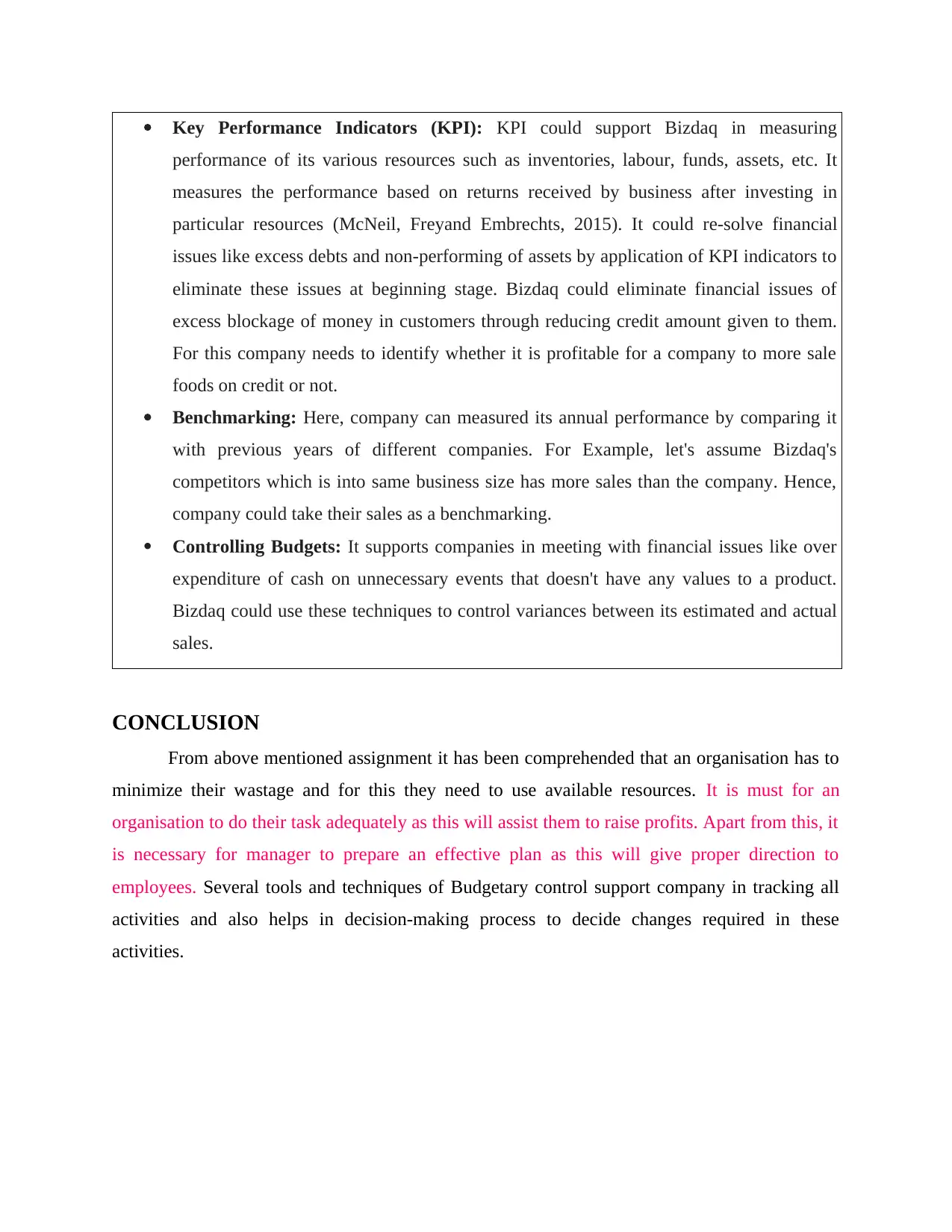
Key Performance Indicators (KPI): KPI could support Bizdaq in measuring
performance of its various resources such as inventories, labour, funds, assets, etc. It
measures the performance based on returns received by business after investing in
particular resources (McNeil, Freyand Embrechts, 2015). It could re-solve financial
issues like excess debts and non-performing of assets by application of KPI indicators to
eliminate these issues at beginning stage. Bizdaq could eliminate financial issues of
excess blockage of money in customers through reducing credit amount given to them.
For this company needs to identify whether it is profitable for a company to more sale
foods on credit or not.
Benchmarking: Here, company can measured its annual performance by comparing it
with previous years of different companies. For Example, let's assume Bizdaq's
competitors which is into same business size has more sales than the company. Hence,
company could take their sales as a benchmarking.
Controlling Budgets: It supports companies in meeting with financial issues like over
expenditure of cash on unnecessary events that doesn't have any values to a product.
Bizdaq could use these techniques to control variances between its estimated and actual
sales.
CONCLUSION
From above mentioned assignment it has been comprehended that an organisation has to
minimize their wastage and for this they need to use available resources. It is must for an
organisation to do their task adequately as this will assist them to raise profits. Apart from this, it
is necessary for manager to prepare an effective plan as this will give proper direction to
employees. Several tools and techniques of Budgetary control support company in tracking all
activities and also helps in decision-making process to decide changes required in these
activities.
performance of its various resources such as inventories, labour, funds, assets, etc. It
measures the performance based on returns received by business after investing in
particular resources (McNeil, Freyand Embrechts, 2015). It could re-solve financial
issues like excess debts and non-performing of assets by application of KPI indicators to
eliminate these issues at beginning stage. Bizdaq could eliminate financial issues of
excess blockage of money in customers through reducing credit amount given to them.
For this company needs to identify whether it is profitable for a company to more sale
foods on credit or not.
Benchmarking: Here, company can measured its annual performance by comparing it
with previous years of different companies. For Example, let's assume Bizdaq's
competitors which is into same business size has more sales than the company. Hence,
company could take their sales as a benchmarking.
Controlling Budgets: It supports companies in meeting with financial issues like over
expenditure of cash on unnecessary events that doesn't have any values to a product.
Bizdaq could use these techniques to control variances between its estimated and actual
sales.
CONCLUSION
From above mentioned assignment it has been comprehended that an organisation has to
minimize their wastage and for this they need to use available resources. It is must for an
organisation to do their task adequately as this will assist them to raise profits. Apart from this, it
is necessary for manager to prepare an effective plan as this will give proper direction to
employees. Several tools and techniques of Budgetary control support company in tracking all
activities and also helps in decision-making process to decide changes required in these
activities.
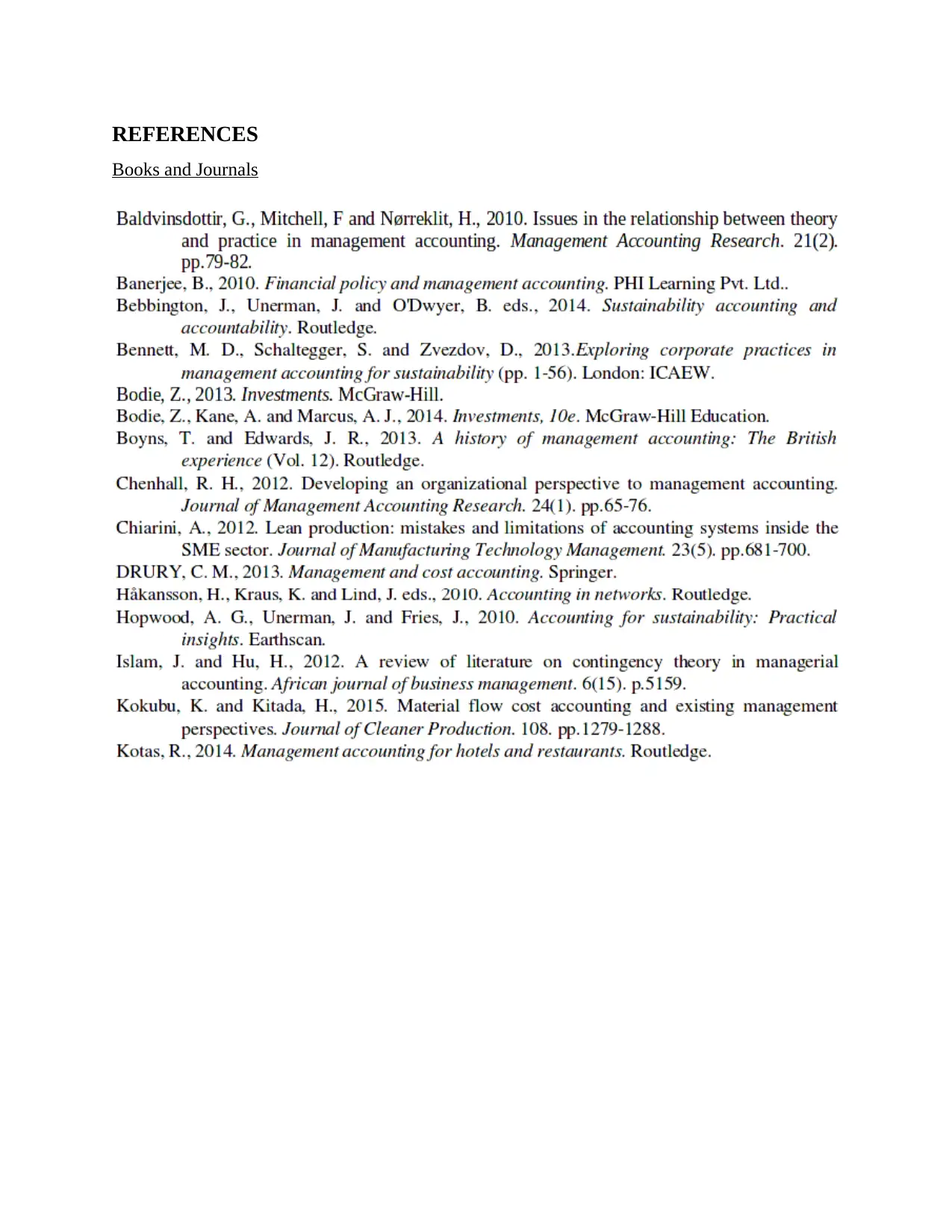
REFERENCES
Books and Journals
Books and Journals
Paraphrase This Document
Need a fresh take? Get an instant paraphrase of this document with our AI Paraphraser
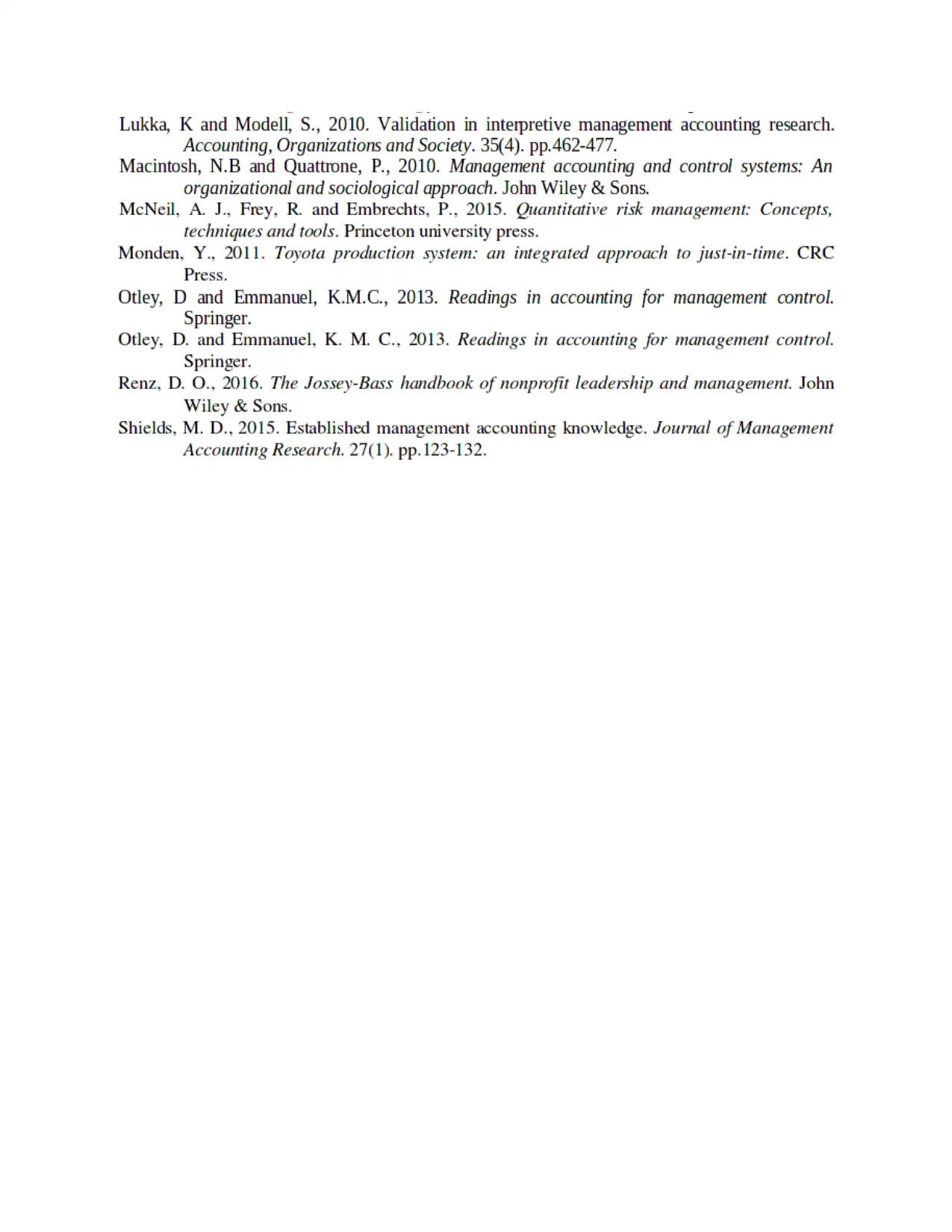
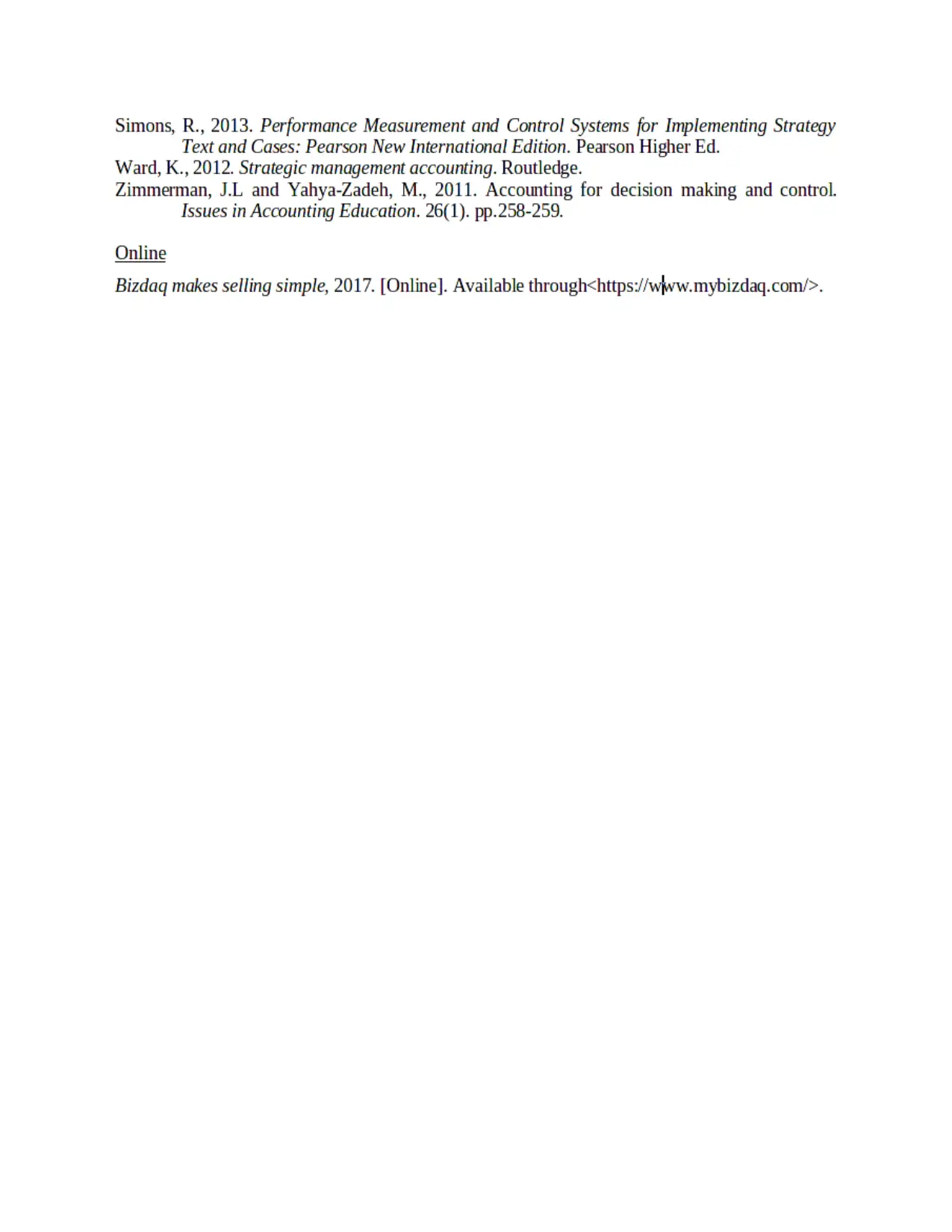
1 out of 21
Related Documents
Your All-in-One AI-Powered Toolkit for Academic Success.
+13062052269
info@desklib.com
Available 24*7 on WhatsApp / Email
![[object Object]](/_next/static/media/star-bottom.7253800d.svg)
Unlock your academic potential
© 2024 | Zucol Services PVT LTD | All rights reserved.





